Child Development Module - Assignment
VerifiedAdded on 2021/05/27
|18
|5486
|149
AI Summary
Contribute Materials
Your contribution can guide someone’s learning journey. Share your
documents today.
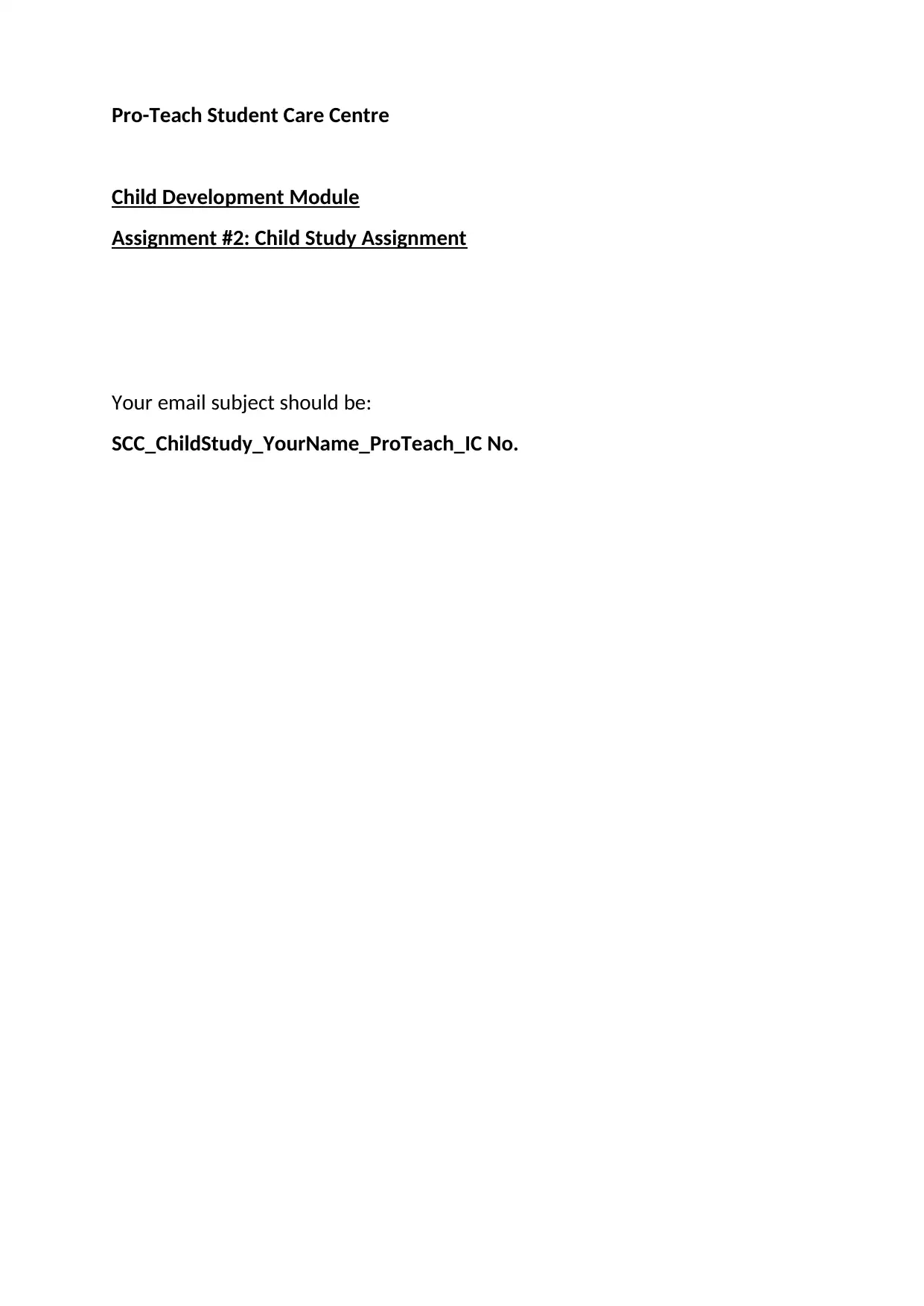
Pro-Teach Student Care Centre
Child Development Module
Assignment #2: Child Study Assignment
Your email subject should be:
SCC_ChildStudy_YourName_ProTeach_IC No.
Child Development Module
Assignment #2: Child Study Assignment
Your email subject should be:
SCC_ChildStudy_YourName_ProTeach_IC No.
Secure Best Marks with AI Grader
Need help grading? Try our AI Grader for instant feedback on your assignments.
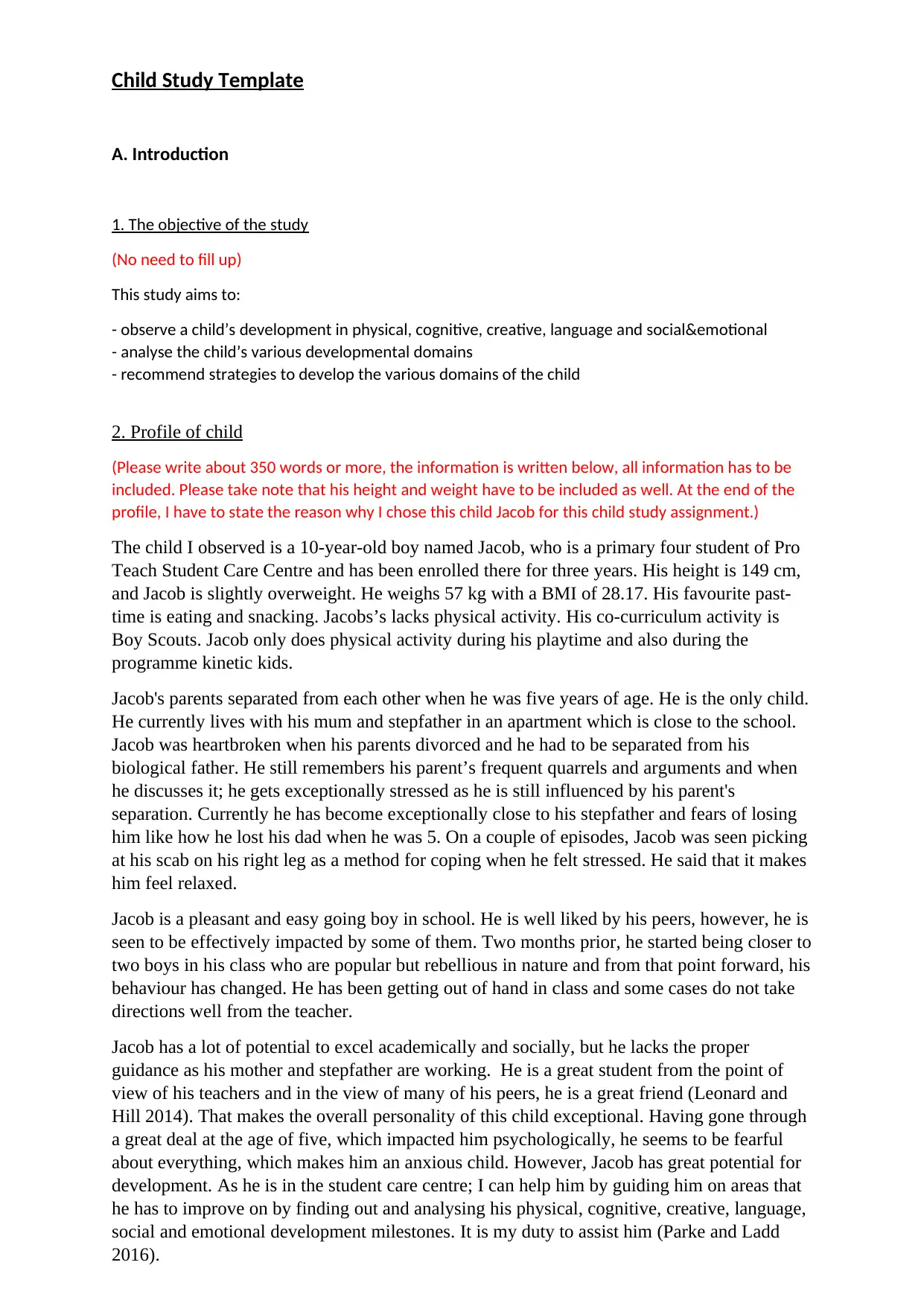
Child Study Template
A. Introduction
1. The objective of the study
(No need to fill up)
This study aims to:
- observe a child’s development in physical, cognitive, creative, language and social&emotional
- analyse the child’s various developmental domains
- recommend strategies to develop the various domains of the child
2. Profile of child
(Please write about 350 words or more, the information is written below, all information has to be
included. Please take note that his height and weight have to be included as well. At the end of the
profile, I have to state the reason why I chose this child Jacob for this child study assignment.)
The child I observed is a 10-year-old boy named Jacob, who is a primary four student of Pro
Teach Student Care Centre and has been enrolled there for three years. His height is 149 cm,
and Jacob is slightly overweight. He weighs 57 kg with a BMI of 28.17. His favourite past-
time is eating and snacking. Jacobs’s lacks physical activity. His co-curriculum activity is
Boy Scouts. Jacob only does physical activity during his playtime and also during the
programme kinetic kids.
Jacob's parents separated from each other when he was five years of age. He is the only child.
He currently lives with his mum and stepfather in an apartment which is close to the school.
Jacob was heartbroken when his parents divorced and he had to be separated from his
biological father. He still remembers his parent’s frequent quarrels and arguments and when
he discusses it; he gets exceptionally stressed as he is still influenced by his parent's
separation. Currently he has become exceptionally close to his stepfather and fears of losing
him like how he lost his dad when he was 5. On a couple of episodes, Jacob was seen picking
at his scab on his right leg as a method for coping when he felt stressed. He said that it makes
him feel relaxed.
Jacob is a pleasant and easy going boy in school. He is well liked by his peers, however, he is
seen to be effectively impacted by some of them. Two months prior, he started being closer to
two boys in his class who are popular but rebellious in nature and from that point forward, his
behaviour has changed. He has been getting out of hand in class and some cases do not take
directions well from the teacher.
Jacob has a lot of potential to excel academically and socially, but he lacks the proper
guidance as his mother and stepfather are working. He is a great student from the point of
view of his teachers and in the view of many of his peers, he is a great friend (Leonard and
Hill 2014). That makes the overall personality of this child exceptional. Having gone through
a great deal at the age of five, which impacted him psychologically, he seems to be fearful
about everything, which makes him an anxious child. However, Jacob has great potential for
development. As he is in the student care centre; I can help him by guiding him on areas that
he has to improve on by finding out and analysing his physical, cognitive, creative, language,
social and emotional development milestones. It is my duty to assist him (Parke and Ladd
2016).
A. Introduction
1. The objective of the study
(No need to fill up)
This study aims to:
- observe a child’s development in physical, cognitive, creative, language and social&emotional
- analyse the child’s various developmental domains
- recommend strategies to develop the various domains of the child
2. Profile of child
(Please write about 350 words or more, the information is written below, all information has to be
included. Please take note that his height and weight have to be included as well. At the end of the
profile, I have to state the reason why I chose this child Jacob for this child study assignment.)
The child I observed is a 10-year-old boy named Jacob, who is a primary four student of Pro
Teach Student Care Centre and has been enrolled there for three years. His height is 149 cm,
and Jacob is slightly overweight. He weighs 57 kg with a BMI of 28.17. His favourite past-
time is eating and snacking. Jacobs’s lacks physical activity. His co-curriculum activity is
Boy Scouts. Jacob only does physical activity during his playtime and also during the
programme kinetic kids.
Jacob's parents separated from each other when he was five years of age. He is the only child.
He currently lives with his mum and stepfather in an apartment which is close to the school.
Jacob was heartbroken when his parents divorced and he had to be separated from his
biological father. He still remembers his parent’s frequent quarrels and arguments and when
he discusses it; he gets exceptionally stressed as he is still influenced by his parent's
separation. Currently he has become exceptionally close to his stepfather and fears of losing
him like how he lost his dad when he was 5. On a couple of episodes, Jacob was seen picking
at his scab on his right leg as a method for coping when he felt stressed. He said that it makes
him feel relaxed.
Jacob is a pleasant and easy going boy in school. He is well liked by his peers, however, he is
seen to be effectively impacted by some of them. Two months prior, he started being closer to
two boys in his class who are popular but rebellious in nature and from that point forward, his
behaviour has changed. He has been getting out of hand in class and some cases do not take
directions well from the teacher.
Jacob has a lot of potential to excel academically and socially, but he lacks the proper
guidance as his mother and stepfather are working. He is a great student from the point of
view of his teachers and in the view of many of his peers, he is a great friend (Leonard and
Hill 2014). That makes the overall personality of this child exceptional. Having gone through
a great deal at the age of five, which impacted him psychologically, he seems to be fearful
about everything, which makes him an anxious child. However, Jacob has great potential for
development. As he is in the student care centre; I can help him by guiding him on areas that
he has to improve on by finding out and analysing his physical, cognitive, creative, language,
social and emotional development milestones. It is my duty to assist him (Parke and Ladd
2016).
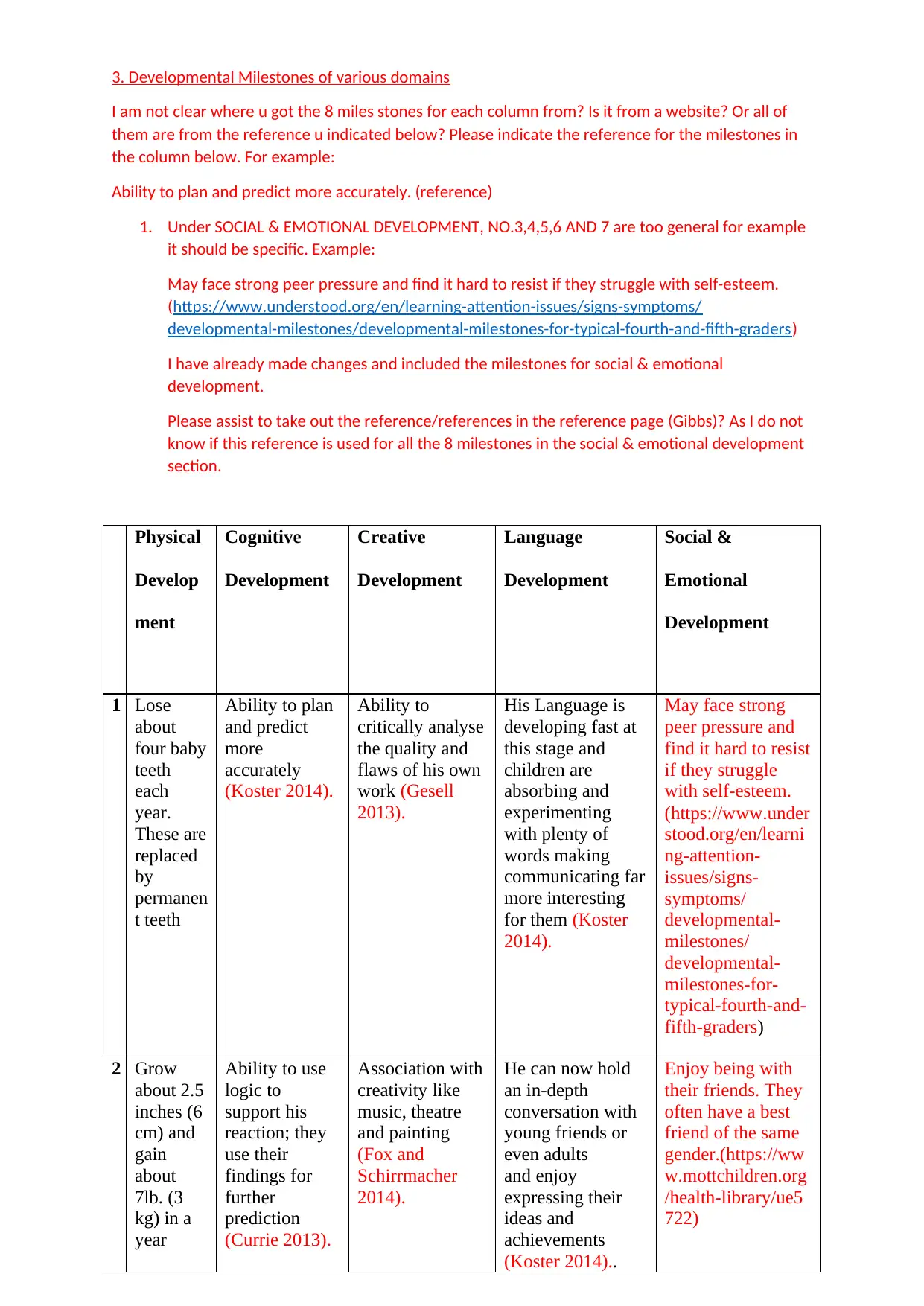
3. Developmental Milestones of various domains
I am not clear where u got the 8 miles stones for each column from? Is it from a website? Or all of
them are from the reference u indicated below? Please indicate the reference for the milestones in
the column below. For example:
Ability to plan and predict more accurately. (reference)
1. Under SOCIAL & EMOTIONAL DEVELOPMENT, NO.3,4,5,6 AND 7 are too general for example
it should be specific. Example:
May face strong peer pressure and find it hard to resist if they struggle with self-esteem.
(https://www.understood.org/en/learning-attention-issues/signs-symptoms/
developmental-milestones/developmental-milestones-for-typical-fourth-and-fifth-graders)
I have already made changes and included the milestones for social & emotional
development.
Please assist to take out the reference/references in the reference page (Gibbs)? As I do not
know if this reference is used for all the 8 milestones in the social & emotional development
section.
Physical
Develop
ment
Cognitive
Development
Creative
Development
Language
Development
Social &
Emotional
Development
1 Lose
about
four baby
teeth
each
year.
These are
replaced
by
permanen
t teeth
Ability to plan
and predict
more
accurately
(Koster 2014).
Ability to
critically analyse
the quality and
flaws of his own
work (Gesell
2013).
His Language is
developing fast at
this stage and
children are
absorbing and
experimenting
with plenty of
words making
communicating far
more interesting
for them (Koster
2014).
May face strong
peer pressure and
find it hard to resist
if they struggle
with self-esteem.
(https://www.under
stood.org/en/learni
ng-attention-
issues/signs-
symptoms/
developmental-
milestones/
developmental-
milestones-for-
typical-fourth-and-
fifth-graders)
2 Grow
about 2.5
inches (6
cm) and
gain
about
7lb. (3
kg) in a
year
Ability to use
logic to
support his
reaction; they
use their
findings for
further
prediction
(Currie 2013).
Association with
creativity like
music, theatre
and painting
(Fox and
Schirrmacher
2014).
He can now hold
an in-depth
conversation with
young friends or
even adults
and enjoy
expressing their
ideas and
achievements
(Koster 2014)..
Enjoy being with
their friends. They
often have a best
friend of the same
gender.(https://ww
w.mottchildren.org
/health-library/ue5
722)
I am not clear where u got the 8 miles stones for each column from? Is it from a website? Or all of
them are from the reference u indicated below? Please indicate the reference for the milestones in
the column below. For example:
Ability to plan and predict more accurately. (reference)
1. Under SOCIAL & EMOTIONAL DEVELOPMENT, NO.3,4,5,6 AND 7 are too general for example
it should be specific. Example:
May face strong peer pressure and find it hard to resist if they struggle with self-esteem.
(https://www.understood.org/en/learning-attention-issues/signs-symptoms/
developmental-milestones/developmental-milestones-for-typical-fourth-and-fifth-graders)
I have already made changes and included the milestones for social & emotional
development.
Please assist to take out the reference/references in the reference page (Gibbs)? As I do not
know if this reference is used for all the 8 milestones in the social & emotional development
section.
Physical
Develop
ment
Cognitive
Development
Creative
Development
Language
Development
Social &
Emotional
Development
1 Lose
about
four baby
teeth
each
year.
These are
replaced
by
permanen
t teeth
Ability to plan
and predict
more
accurately
(Koster 2014).
Ability to
critically analyse
the quality and
flaws of his own
work (Gesell
2013).
His Language is
developing fast at
this stage and
children are
absorbing and
experimenting
with plenty of
words making
communicating far
more interesting
for them (Koster
2014).
May face strong
peer pressure and
find it hard to resist
if they struggle
with self-esteem.
(https://www.under
stood.org/en/learni
ng-attention-
issues/signs-
symptoms/
developmental-
milestones/
developmental-
milestones-for-
typical-fourth-and-
fifth-graders)
2 Grow
about 2.5
inches (6
cm) and
gain
about
7lb. (3
kg) in a
year
Ability to use
logic to
support his
reaction; they
use their
findings for
further
prediction
(Currie 2013).
Association with
creativity like
music, theatre
and painting
(Fox and
Schirrmacher
2014).
He can now hold
an in-depth
conversation with
young friends or
even adults
and enjoy
expressing their
ideas and
achievements
(Koster 2014)..
Enjoy being with
their friends. They
often have a best
friend of the same
gender.(https://ww
w.mottchildren.org
/health-library/ue5
722)
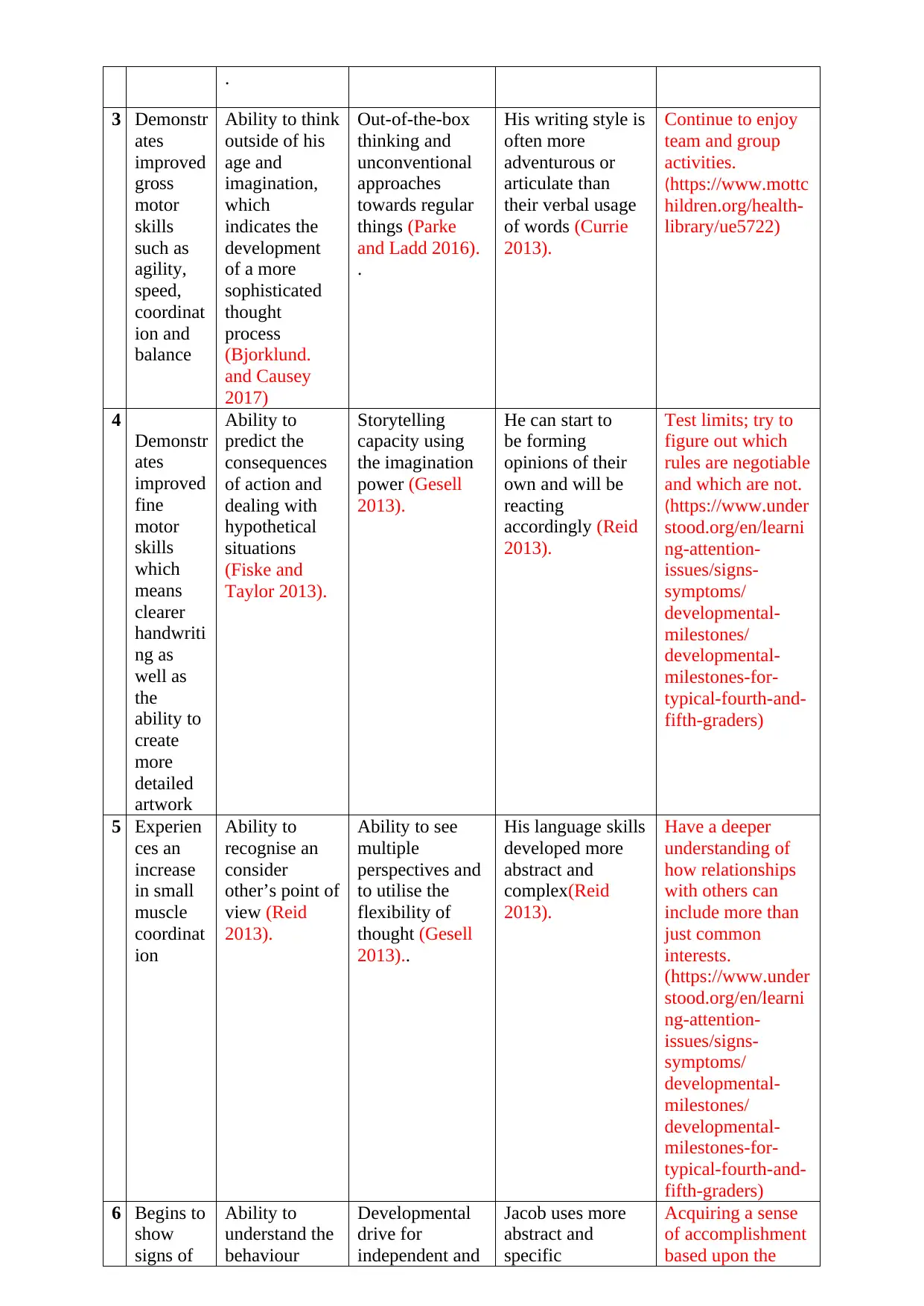
.
3 Demonstr
ates
improved
gross
motor
skills
such as
agility,
speed,
coordinat
ion and
balance
Ability to think
outside of his
age and
imagination,
which
indicates the
development
of a more
sophisticated
thought
process
(Bjorklund.
and Causey
2017)
Out-of-the-box
thinking and
unconventional
approaches
towards regular
things (Parke
and Ladd 2016).
.
His writing style is
often more
adventurous or
articulate than
their verbal usage
of words (Currie
2013).
Continue to enjoy
team and group
activities.
(https://www.mottc
hildren.org/health-
library/ue5722)
4
Demonstr
ates
improved
fine
motor
skills
which
means
clearer
handwriti
ng as
well as
the
ability to
create
more
detailed
artwork
Ability to
predict the
consequences
of action and
dealing with
hypothetical
situations
(Fiske and
Taylor 2013).
Storytelling
capacity using
the imagination
power (Gesell
2013).
He can start to
be forming
opinions of their
own and will be
reacting
accordingly (Reid
2013).
Test limits; try to
figure out which
rules are negotiable
and which are not.
(https://www.under
stood.org/en/learni
ng-attention-
issues/signs-
symptoms/
developmental-
milestones/
developmental-
milestones-for-
typical-fourth-and-
fifth-graders)
5 Experien
ces an
increase
in small
muscle
coordinat
ion
Ability to
recognise an
consider
other’s point of
view (Reid
2013).
Ability to see
multiple
perspectives and
to utilise the
flexibility of
thought (Gesell
2013)..
His language skills
developed more
abstract and
complex(Reid
2013).
Have a deeper
understanding of
how relationships
with others can
include more than
just common
interests.
(https://www.under
stood.org/en/learni
ng-attention-
issues/signs-
symptoms/
developmental-
milestones/
developmental-
milestones-for-
typical-fourth-and-
fifth-graders)
6 Begins to
show
signs of
Ability to
understand the
behaviour
Developmental
drive for
independent and
Jacob uses more
abstract and
specific
Acquiring a sense
of accomplishment
based upon the
3 Demonstr
ates
improved
gross
motor
skills
such as
agility,
speed,
coordinat
ion and
balance
Ability to think
outside of his
age and
imagination,
which
indicates the
development
of a more
sophisticated
thought
process
(Bjorklund.
and Causey
2017)
Out-of-the-box
thinking and
unconventional
approaches
towards regular
things (Parke
and Ladd 2016).
.
His writing style is
often more
adventurous or
articulate than
their verbal usage
of words (Currie
2013).
Continue to enjoy
team and group
activities.
(https://www.mottc
hildren.org/health-
library/ue5722)
4
Demonstr
ates
improved
fine
motor
skills
which
means
clearer
handwriti
ng as
well as
the
ability to
create
more
detailed
artwork
Ability to
predict the
consequences
of action and
dealing with
hypothetical
situations
(Fiske and
Taylor 2013).
Storytelling
capacity using
the imagination
power (Gesell
2013).
He can start to
be forming
opinions of their
own and will be
reacting
accordingly (Reid
2013).
Test limits; try to
figure out which
rules are negotiable
and which are not.
(https://www.under
stood.org/en/learni
ng-attention-
issues/signs-
symptoms/
developmental-
milestones/
developmental-
milestones-for-
typical-fourth-and-
fifth-graders)
5 Experien
ces an
increase
in small
muscle
coordinat
ion
Ability to
recognise an
consider
other’s point of
view (Reid
2013).
Ability to see
multiple
perspectives and
to utilise the
flexibility of
thought (Gesell
2013)..
His language skills
developed more
abstract and
complex(Reid
2013).
Have a deeper
understanding of
how relationships
with others can
include more than
just common
interests.
(https://www.under
stood.org/en/learni
ng-attention-
issues/signs-
symptoms/
developmental-
milestones/
developmental-
milestones-for-
typical-fourth-and-
fifth-graders)
6 Begins to
show
signs of
Ability to
understand the
behaviour
Developmental
drive for
independent and
Jacob uses more
abstract and
specific
Acquiring a sense
of accomplishment
based upon the
Secure Best Marks with AI Grader
Need help grading? Try our AI Grader for instant feedback on your assignments.
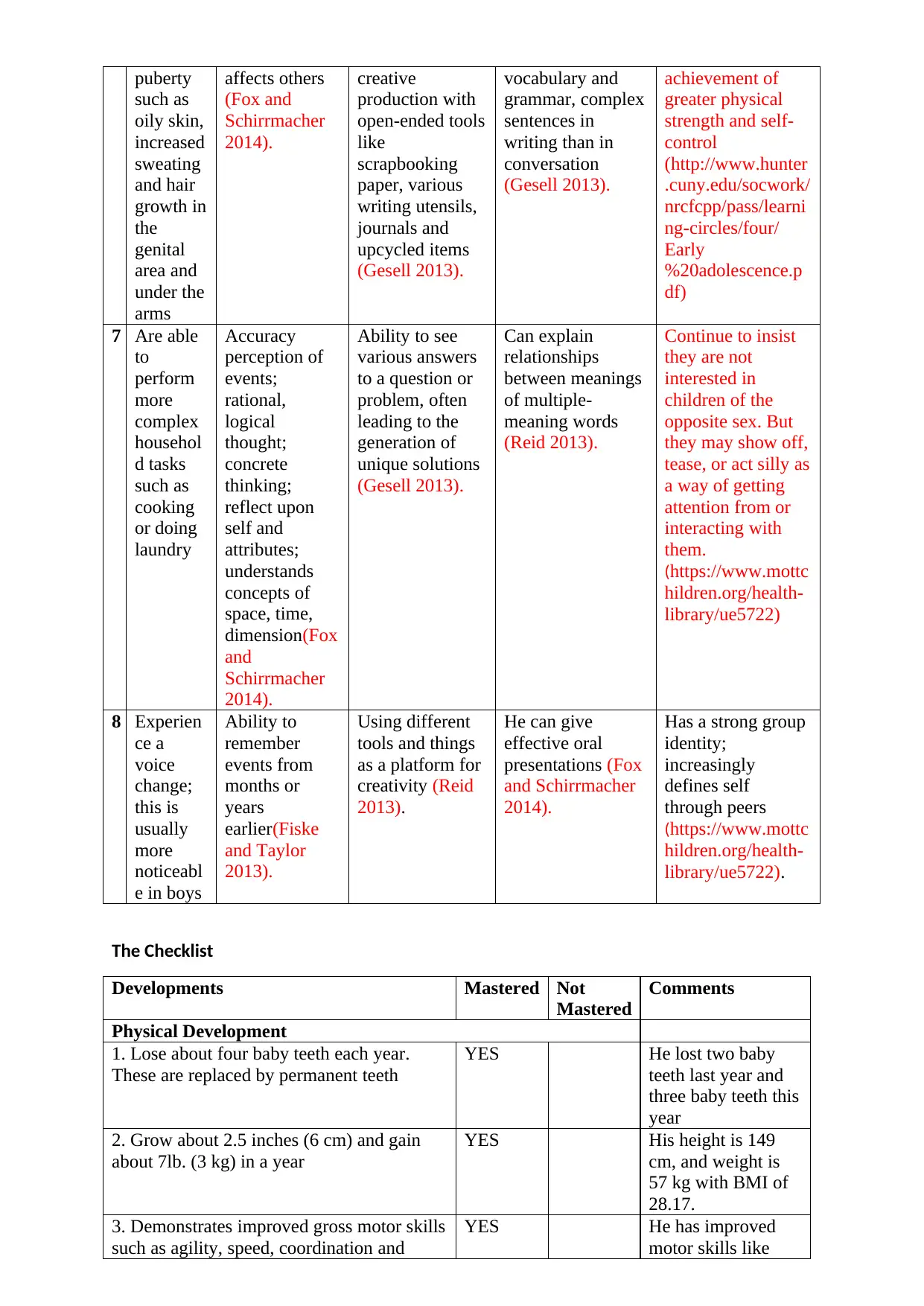
puberty
such as
oily skin,
increased
sweating
and hair
growth in
the
genital
area and
under the
arms
affects others
(Fox and
Schirrmacher
2014).
creative
production with
open-ended tools
like
scrapbooking
paper, various
writing utensils,
journals and
upcycled items
(Gesell 2013).
vocabulary and
grammar, complex
sentences in
writing than in
conversation
(Gesell 2013).
achievement of
greater physical
strength and self-
control
(http://www.hunter
.cuny.edu/socwork/
nrcfcpp/pass/learni
ng-circles/four/
Early
%20adolescence.p
df)
7 Are able
to
perform
more
complex
househol
d tasks
such as
cooking
or doing
laundry
Accuracy
perception of
events;
rational,
logical
thought;
concrete
thinking;
reflect upon
self and
attributes;
understands
concepts of
space, time,
dimension(Fox
and
Schirrmacher
2014).
Ability to see
various answers
to a question or
problem, often
leading to the
generation of
unique solutions
(Gesell 2013).
Can explain
relationships
between meanings
of multiple-
meaning words
(Reid 2013).
Continue to insist
they are not
interested in
children of the
opposite sex. But
they may show off,
tease, or act silly as
a way of getting
attention from or
interacting with
them.
(https://www.mottc
hildren.org/health-
library/ue5722)
8 Experien
ce a
voice
change;
this is
usually
more
noticeabl
e in boys
Ability to
remember
events from
months or
years
earlier(Fiske
and Taylor
2013).
Using different
tools and things
as a platform for
creativity (Reid
2013).
He can give
effective oral
presentations (Fox
and Schirrmacher
2014).
Has a strong group
identity;
increasingly
defines self
through peers
(https://www.mottc
hildren.org/health-
library/ue5722).
The Checklist
Developments Mastered Not
Mastered
Comments
Physical Development
1. Lose about four baby teeth each year.
These are replaced by permanent teeth
YES He lost two baby
teeth last year and
three baby teeth this
year
2. Grow about 2.5 inches (6 cm) and gain
about 7lb. (3 kg) in a year
YES His height is 149
cm, and weight is
57 kg with BMI of
28.17.
3. Demonstrates improved gross motor skills
such as agility, speed, coordination and
YES He has improved
motor skills like
such as
oily skin,
increased
sweating
and hair
growth in
the
genital
area and
under the
arms
affects others
(Fox and
Schirrmacher
2014).
creative
production with
open-ended tools
like
scrapbooking
paper, various
writing utensils,
journals and
upcycled items
(Gesell 2013).
vocabulary and
grammar, complex
sentences in
writing than in
conversation
(Gesell 2013).
achievement of
greater physical
strength and self-
control
(http://www.hunter
.cuny.edu/socwork/
nrcfcpp/pass/learni
ng-circles/four/
Early
%20adolescence.p
df)
7 Are able
to
perform
more
complex
househol
d tasks
such as
cooking
or doing
laundry
Accuracy
perception of
events;
rational,
logical
thought;
concrete
thinking;
reflect upon
self and
attributes;
understands
concepts of
space, time,
dimension(Fox
and
Schirrmacher
2014).
Ability to see
various answers
to a question or
problem, often
leading to the
generation of
unique solutions
(Gesell 2013).
Can explain
relationships
between meanings
of multiple-
meaning words
(Reid 2013).
Continue to insist
they are not
interested in
children of the
opposite sex. But
they may show off,
tease, or act silly as
a way of getting
attention from or
interacting with
them.
(https://www.mottc
hildren.org/health-
library/ue5722)
8 Experien
ce a
voice
change;
this is
usually
more
noticeabl
e in boys
Ability to
remember
events from
months or
years
earlier(Fiske
and Taylor
2013).
Using different
tools and things
as a platform for
creativity (Reid
2013).
He can give
effective oral
presentations (Fox
and Schirrmacher
2014).
Has a strong group
identity;
increasingly
defines self
through peers
(https://www.mottc
hildren.org/health-
library/ue5722).
The Checklist
Developments Mastered Not
Mastered
Comments
Physical Development
1. Lose about four baby teeth each year.
These are replaced by permanent teeth
YES He lost two baby
teeth last year and
three baby teeth this
year
2. Grow about 2.5 inches (6 cm) and gain
about 7lb. (3 kg) in a year
YES His height is 149
cm, and weight is
57 kg with BMI of
28.17.
3. Demonstrates improved gross motor skills
such as agility, speed, coordination and
YES He has improved
motor skills like
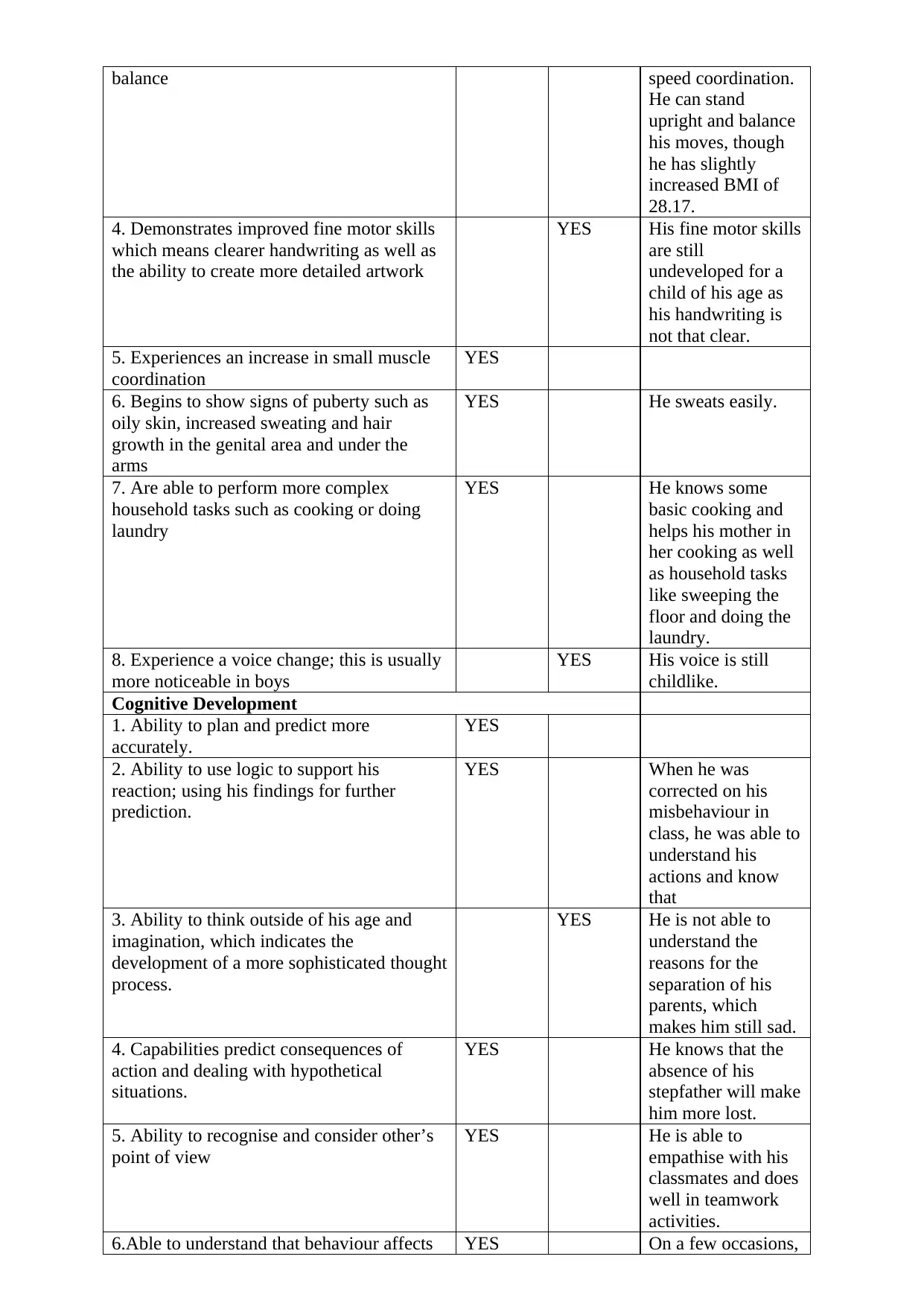
balance speed coordination.
He can stand
upright and balance
his moves, though
he has slightly
increased BMI of
28.17.
4. Demonstrates improved fine motor skills
which means clearer handwriting as well as
the ability to create more detailed artwork
YES His fine motor skills
are still
undeveloped for a
child of his age as
his handwriting is
not that clear.
5. Experiences an increase in small muscle
coordination
YES
6. Begins to show signs of puberty such as
oily skin, increased sweating and hair
growth in the genital area and under the
arms
YES He sweats easily.
7. Are able to perform more complex
household tasks such as cooking or doing
laundry
YES He knows some
basic cooking and
helps his mother in
her cooking as well
as household tasks
like sweeping the
floor and doing the
laundry.
8. Experience a voice change; this is usually
more noticeable in boys
YES His voice is still
childlike.
Cognitive Development
1. Ability to plan and predict more
accurately.
YES
2. Ability to use logic to support his
reaction; using his findings for further
prediction.
YES When he was
corrected on his
misbehaviour in
class, he was able to
understand his
actions and know
that
3. Ability to think outside of his age and
imagination, which indicates the
development of a more sophisticated thought
process.
YES He is not able to
understand the
reasons for the
separation of his
parents, which
makes him still sad.
4. Capabilities predict consequences of
action and dealing with hypothetical
situations.
YES He knows that the
absence of his
stepfather will make
him more lost.
5. Ability to recognise and consider other’s
point of view
YES He is able to
empathise with his
classmates and does
well in teamwork
activities.
6.Able to understand that behaviour affects YES On a few occasions,
He can stand
upright and balance
his moves, though
he has slightly
increased BMI of
28.17.
4. Demonstrates improved fine motor skills
which means clearer handwriting as well as
the ability to create more detailed artwork
YES His fine motor skills
are still
undeveloped for a
child of his age as
his handwriting is
not that clear.
5. Experiences an increase in small muscle
coordination
YES
6. Begins to show signs of puberty such as
oily skin, increased sweating and hair
growth in the genital area and under the
arms
YES He sweats easily.
7. Are able to perform more complex
household tasks such as cooking or doing
laundry
YES He knows some
basic cooking and
helps his mother in
her cooking as well
as household tasks
like sweeping the
floor and doing the
laundry.
8. Experience a voice change; this is usually
more noticeable in boys
YES His voice is still
childlike.
Cognitive Development
1. Ability to plan and predict more
accurately.
YES
2. Ability to use logic to support his
reaction; using his findings for further
prediction.
YES When he was
corrected on his
misbehaviour in
class, he was able to
understand his
actions and know
that
3. Ability to think outside of his age and
imagination, which indicates the
development of a more sophisticated thought
process.
YES He is not able to
understand the
reasons for the
separation of his
parents, which
makes him still sad.
4. Capabilities predict consequences of
action and dealing with hypothetical
situations.
YES He knows that the
absence of his
stepfather will make
him more lost.
5. Ability to recognise and consider other’s
point of view
YES He is able to
empathise with his
classmates and does
well in teamwork
activities.
6.Able to understand that behaviour affects YES On a few occasions,
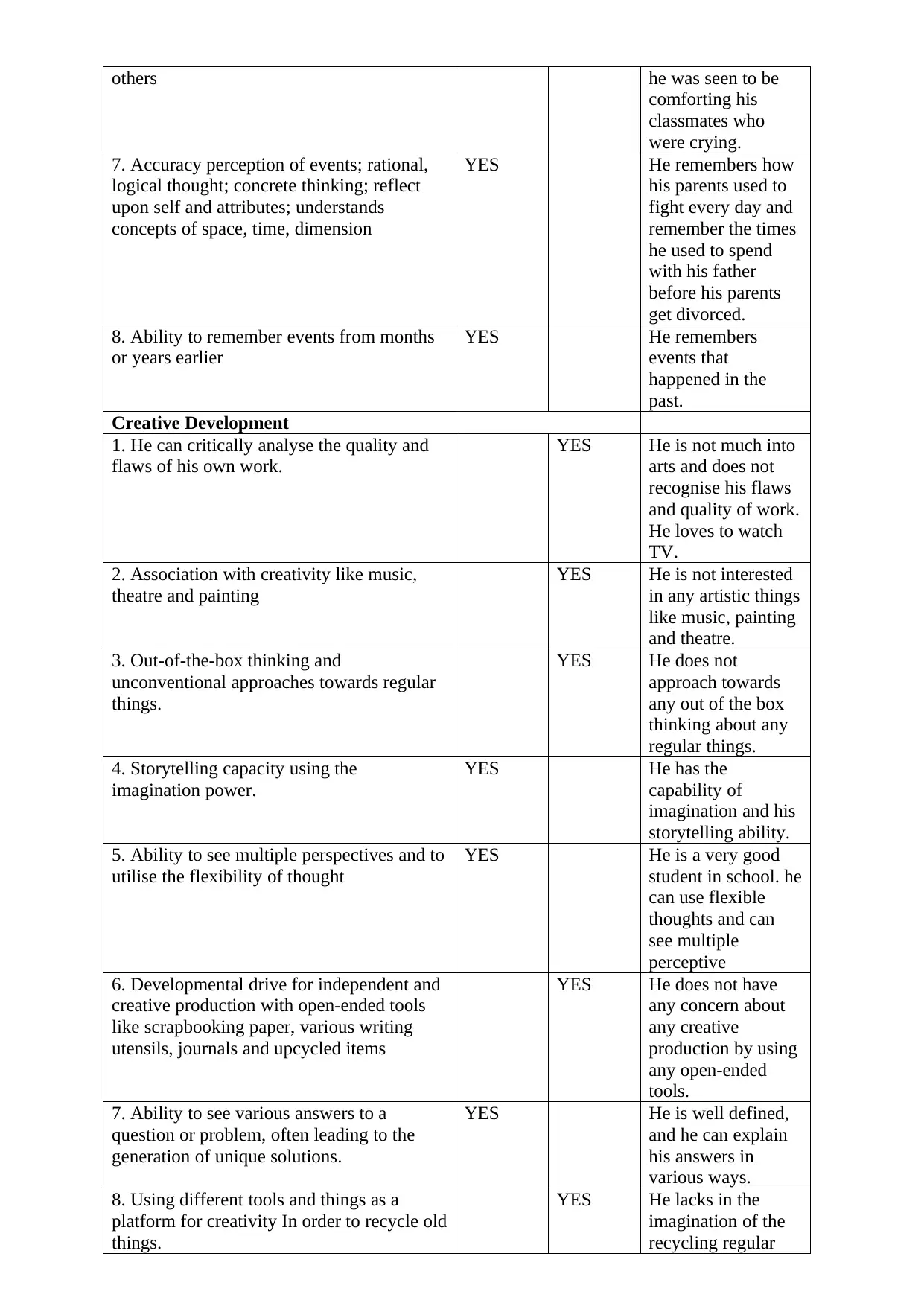
others he was seen to be
comforting his
classmates who
were crying.
7. Accuracy perception of events; rational,
logical thought; concrete thinking; reflect
upon self and attributes; understands
concepts of space, time, dimension
YES He remembers how
his parents used to
fight every day and
remember the times
he used to spend
with his father
before his parents
get divorced.
8. Ability to remember events from months
or years earlier
YES He remembers
events that
happened in the
past.
Creative Development
1. He can critically analyse the quality and
flaws of his own work.
YES He is not much into
arts and does not
recognise his flaws
and quality of work.
He loves to watch
TV.
2. Association with creativity like music,
theatre and painting
YES He is not interested
in any artistic things
like music, painting
and theatre.
3. Out-of-the-box thinking and
unconventional approaches towards regular
things.
YES He does not
approach towards
any out of the box
thinking about any
regular things.
4. Storytelling capacity using the
imagination power.
YES He has the
capability of
imagination and his
storytelling ability.
5. Ability to see multiple perspectives and to
utilise the flexibility of thought
YES He is a very good
student in school. he
can use flexible
thoughts and can
see multiple
perceptive
6. Developmental drive for independent and
creative production with open-ended tools
like scrapbooking paper, various writing
utensils, journals and upcycled items
YES He does not have
any concern about
any creative
production by using
any open-ended
tools.
7. Ability to see various answers to a
question or problem, often leading to the
generation of unique solutions.
YES He is well defined,
and he can explain
his answers in
various ways.
8. Using different tools and things as a
platform for creativity In order to recycle old
things.
YES He lacks in the
imagination of the
recycling regular
comforting his
classmates who
were crying.
7. Accuracy perception of events; rational,
logical thought; concrete thinking; reflect
upon self and attributes; understands
concepts of space, time, dimension
YES He remembers how
his parents used to
fight every day and
remember the times
he used to spend
with his father
before his parents
get divorced.
8. Ability to remember events from months
or years earlier
YES He remembers
events that
happened in the
past.
Creative Development
1. He can critically analyse the quality and
flaws of his own work.
YES He is not much into
arts and does not
recognise his flaws
and quality of work.
He loves to watch
TV.
2. Association with creativity like music,
theatre and painting
YES He is not interested
in any artistic things
like music, painting
and theatre.
3. Out-of-the-box thinking and
unconventional approaches towards regular
things.
YES He does not
approach towards
any out of the box
thinking about any
regular things.
4. Storytelling capacity using the
imagination power.
YES He has the
capability of
imagination and his
storytelling ability.
5. Ability to see multiple perspectives and to
utilise the flexibility of thought
YES He is a very good
student in school. he
can use flexible
thoughts and can
see multiple
perceptive
6. Developmental drive for independent and
creative production with open-ended tools
like scrapbooking paper, various writing
utensils, journals and upcycled items
YES He does not have
any concern about
any creative
production by using
any open-ended
tools.
7. Ability to see various answers to a
question or problem, often leading to the
generation of unique solutions.
YES He is well defined,
and he can explain
his answers in
various ways.
8. Using different tools and things as a
platform for creativity In order to recycle old
things.
YES He lacks in the
imagination of the
recycling regular
Paraphrase This Document
Need a fresh take? Get an instant paraphrase of this document with our AI Paraphraser
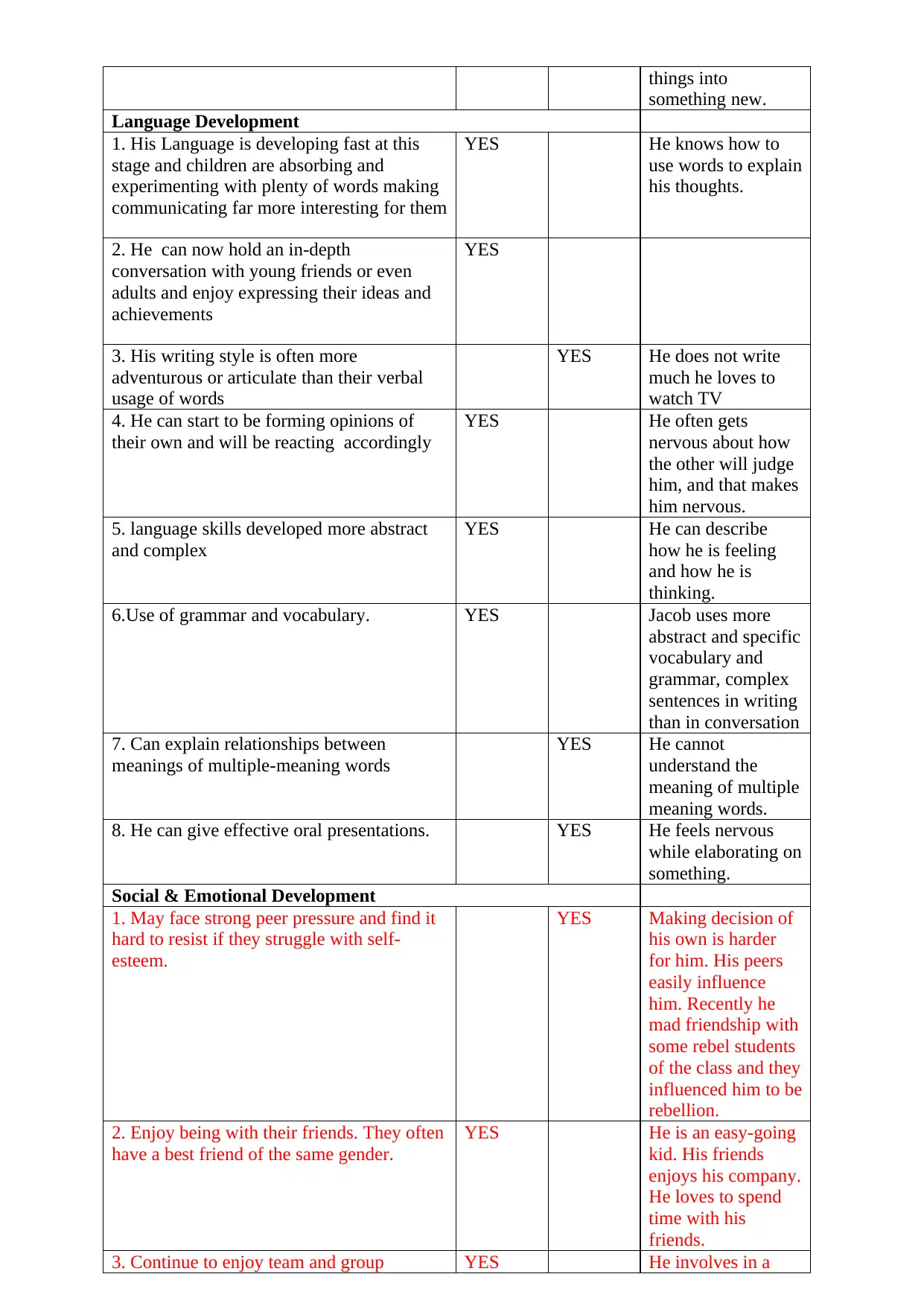
things into
something new.
Language Development
1. His Language is developing fast at this
stage and children are absorbing and
experimenting with plenty of words making
communicating far more interesting for them
YES He knows how to
use words to explain
his thoughts.
2. He can now hold an in-depth
conversation with young friends or even
adults and enjoy expressing their ideas and
achievements
YES
3. His writing style is often more
adventurous or articulate than their verbal
usage of words
YES He does not write
much he loves to
watch TV
4. He can start to be forming opinions of
their own and will be reacting accordingly
YES He often gets
nervous about how
the other will judge
him, and that makes
him nervous.
5. language skills developed more abstract
and complex
YES He can describe
how he is feeling
and how he is
thinking.
6.Use of grammar and vocabulary. YES Jacob uses more
abstract and specific
vocabulary and
grammar, complex
sentences in writing
than in conversation
7. Can explain relationships between
meanings of multiple-meaning words
YES He cannot
understand the
meaning of multiple
meaning words.
8. He can give effective oral presentations. YES He feels nervous
while elaborating on
something.
Social & Emotional Development
1. May face strong peer pressure and find it
hard to resist if they struggle with self-
esteem.
YES Making decision of
his own is harder
for him. His peers
easily influence
him. Recently he
mad friendship with
some rebel students
of the class and they
influenced him to be
rebellion.
2. Enjoy being with their friends. They often
have a best friend of the same gender.
YES He is an easy-going
kid. His friends
enjoys his company.
He loves to spend
time with his
friends.
3. Continue to enjoy team and group YES He involves in a
something new.
Language Development
1. His Language is developing fast at this
stage and children are absorbing and
experimenting with plenty of words making
communicating far more interesting for them
YES He knows how to
use words to explain
his thoughts.
2. He can now hold an in-depth
conversation with young friends or even
adults and enjoy expressing their ideas and
achievements
YES
3. His writing style is often more
adventurous or articulate than their verbal
usage of words
YES He does not write
much he loves to
watch TV
4. He can start to be forming opinions of
their own and will be reacting accordingly
YES He often gets
nervous about how
the other will judge
him, and that makes
him nervous.
5. language skills developed more abstract
and complex
YES He can describe
how he is feeling
and how he is
thinking.
6.Use of grammar and vocabulary. YES Jacob uses more
abstract and specific
vocabulary and
grammar, complex
sentences in writing
than in conversation
7. Can explain relationships between
meanings of multiple-meaning words
YES He cannot
understand the
meaning of multiple
meaning words.
8. He can give effective oral presentations. YES He feels nervous
while elaborating on
something.
Social & Emotional Development
1. May face strong peer pressure and find it
hard to resist if they struggle with self-
esteem.
YES Making decision of
his own is harder
for him. His peers
easily influence
him. Recently he
mad friendship with
some rebel students
of the class and they
influenced him to be
rebellion.
2. Enjoy being with their friends. They often
have a best friend of the same gender.
YES He is an easy-going
kid. His friends
enjoys his company.
He loves to spend
time with his
friends.
3. Continue to enjoy team and group YES He involves in a
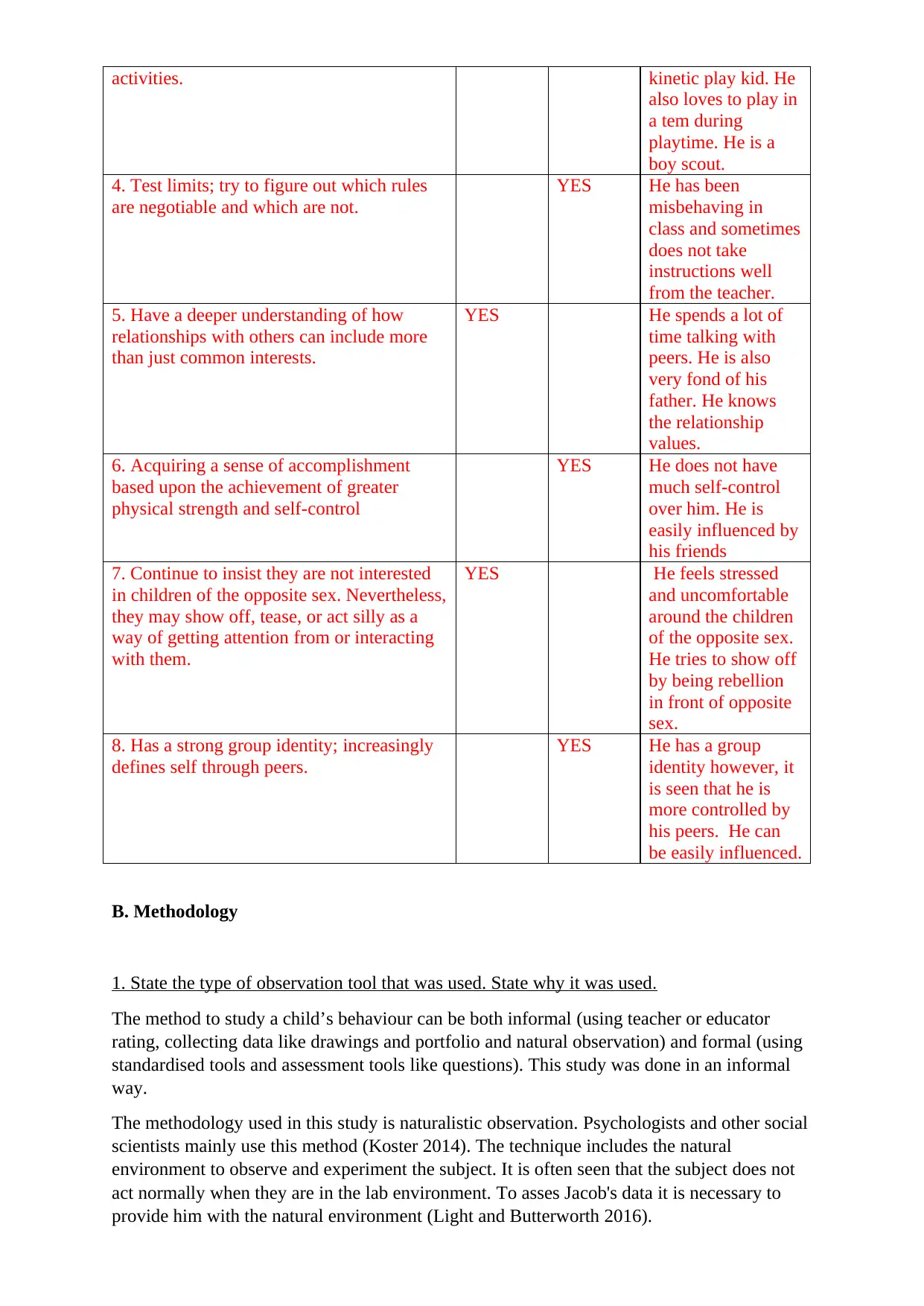
activities. kinetic play kid. He
also loves to play in
a tem during
playtime. He is a
boy scout.
4. Test limits; try to figure out which rules
are negotiable and which are not.
YES He has been
misbehaving in
class and sometimes
does not take
instructions well
from the teacher.
5. Have a deeper understanding of how
relationships with others can include more
than just common interests.
YES He spends a lot of
time talking with
peers. He is also
very fond of his
father. He knows
the relationship
values.
6. Acquiring a sense of accomplishment
based upon the achievement of greater
physical strength and self-control
YES He does not have
much self-control
over him. He is
easily influenced by
his friends
7. Continue to insist they are not interested
in children of the opposite sex. Nevertheless,
they may show off, tease, or act silly as a
way of getting attention from or interacting
with them.
YES He feels stressed
and uncomfortable
around the children
of the opposite sex.
He tries to show off
by being rebellion
in front of opposite
sex.
8. Has a strong group identity; increasingly
defines self through peers.
YES He has a group
identity however, it
is seen that he is
more controlled by
his peers. He can
be easily influenced.
B. Methodology
1. State the type of observation tool that was used. State why it was used.
The method to study a child’s behaviour can be both informal (using teacher or educator
rating, collecting data like drawings and portfolio and natural observation) and formal (using
standardised tools and assessment tools like questions). This study was done in an informal
way.
The methodology used in this study is naturalistic observation. Psychologists and other social
scientists mainly use this method (Koster 2014). The technique includes the natural
environment to observe and experiment the subject. It is often seen that the subject does not
act normally when they are in the lab environment. To asses Jacob's data it is necessary to
provide him with the natural environment (Light and Butterworth 2016).
also loves to play in
a tem during
playtime. He is a
boy scout.
4. Test limits; try to figure out which rules
are negotiable and which are not.
YES He has been
misbehaving in
class and sometimes
does not take
instructions well
from the teacher.
5. Have a deeper understanding of how
relationships with others can include more
than just common interests.
YES He spends a lot of
time talking with
peers. He is also
very fond of his
father. He knows
the relationship
values.
6. Acquiring a sense of accomplishment
based upon the achievement of greater
physical strength and self-control
YES He does not have
much self-control
over him. He is
easily influenced by
his friends
7. Continue to insist they are not interested
in children of the opposite sex. Nevertheless,
they may show off, tease, or act silly as a
way of getting attention from or interacting
with them.
YES He feels stressed
and uncomfortable
around the children
of the opposite sex.
He tries to show off
by being rebellion
in front of opposite
sex.
8. Has a strong group identity; increasingly
defines self through peers.
YES He has a group
identity however, it
is seen that he is
more controlled by
his peers. He can
be easily influenced.
B. Methodology
1. State the type of observation tool that was used. State why it was used.
The method to study a child’s behaviour can be both informal (using teacher or educator
rating, collecting data like drawings and portfolio and natural observation) and formal (using
standardised tools and assessment tools like questions). This study was done in an informal
way.
The methodology used in this study is naturalistic observation. Psychologists and other social
scientists mainly use this method (Koster 2014). The technique includes the natural
environment to observe and experiment the subject. It is often seen that the subject does not
act normally when they are in the lab environment. To asses Jacob's data it is necessary to
provide him with the natural environment (Light and Butterworth 2016).
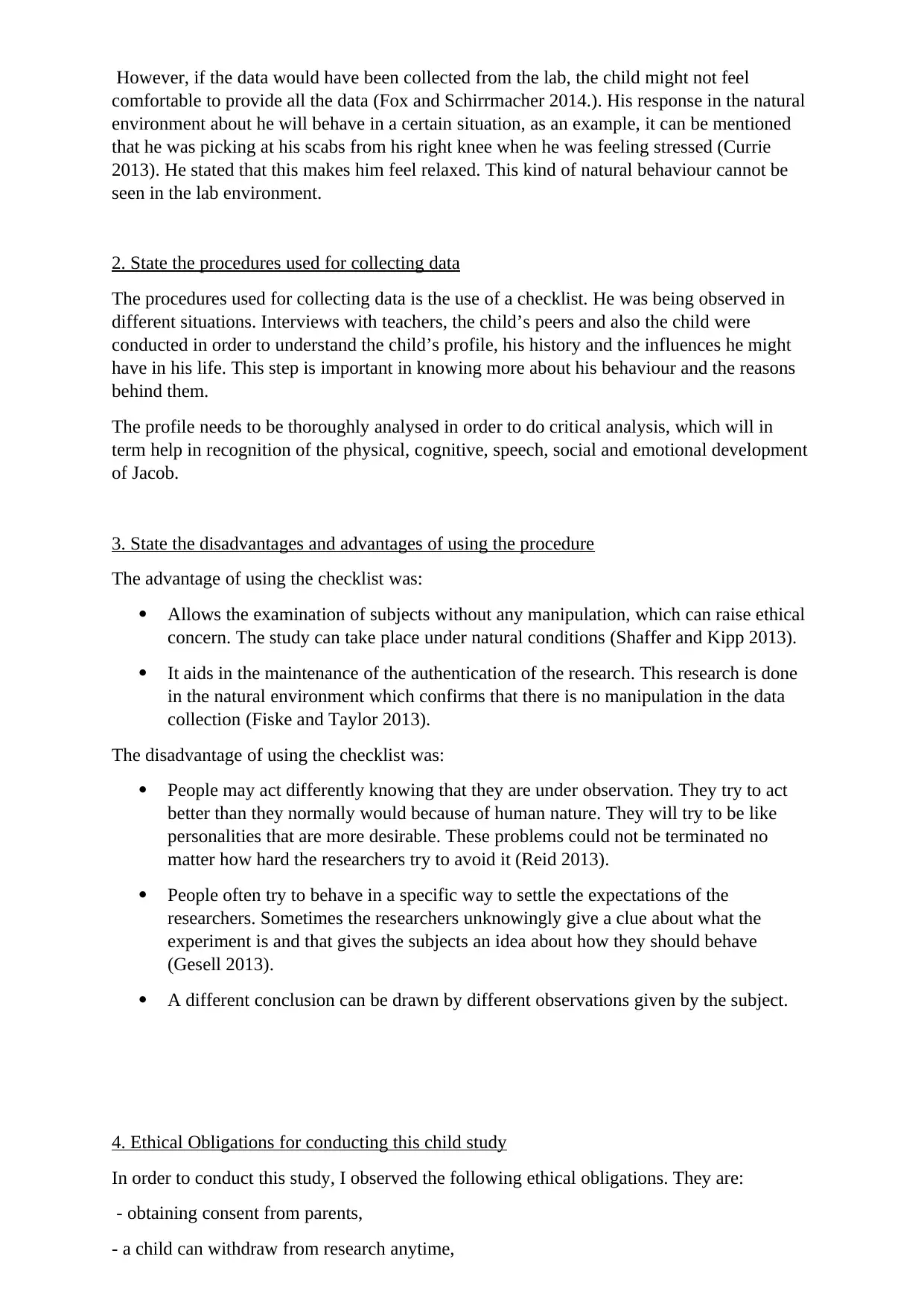
However, if the data would have been collected from the lab, the child might not feel
comfortable to provide all the data (Fox and Schirrmacher 2014.). His response in the natural
environment about he will behave in a certain situation, as an example, it can be mentioned
that he was picking at his scabs from his right knee when he was feeling stressed (Currie
2013). He stated that this makes him feel relaxed. This kind of natural behaviour cannot be
seen in the lab environment.
2. State the procedures used for collecting data
The procedures used for collecting data is the use of a checklist. He was being observed in
different situations. Interviews with teachers, the child’s peers and also the child were
conducted in order to understand the child’s profile, his history and the influences he might
have in his life. This step is important in knowing more about his behaviour and the reasons
behind them.
The profile needs to be thoroughly analysed in order to do critical analysis, which will in
term help in recognition of the physical, cognitive, speech, social and emotional development
of Jacob.
3. State the disadvantages and advantages of using the procedure
The advantage of using the checklist was:
Allows the examination of subjects without any manipulation, which can raise ethical
concern. The study can take place under natural conditions (Shaffer and Kipp 2013).
It aids in the maintenance of the authentication of the research. This research is done
in the natural environment which confirms that there is no manipulation in the data
collection (Fiske and Taylor 2013).
The disadvantage of using the checklist was:
People may act differently knowing that they are under observation. They try to act
better than they normally would because of human nature. They will try to be like
personalities that are more desirable. These problems could not be terminated no
matter how hard the researchers try to avoid it (Reid 2013).
People often try to behave in a specific way to settle the expectations of the
researchers. Sometimes the researchers unknowingly give a clue about what the
experiment is and that gives the subjects an idea about how they should behave
(Gesell 2013).
A different conclusion can be drawn by different observations given by the subject.
4. Ethical Obligations for conducting this child study
In order to conduct this study, I observed the following ethical obligations. They are:
- obtaining consent from parents,
- a child can withdraw from research anytime,
comfortable to provide all the data (Fox and Schirrmacher 2014.). His response in the natural
environment about he will behave in a certain situation, as an example, it can be mentioned
that he was picking at his scabs from his right knee when he was feeling stressed (Currie
2013). He stated that this makes him feel relaxed. This kind of natural behaviour cannot be
seen in the lab environment.
2. State the procedures used for collecting data
The procedures used for collecting data is the use of a checklist. He was being observed in
different situations. Interviews with teachers, the child’s peers and also the child were
conducted in order to understand the child’s profile, his history and the influences he might
have in his life. This step is important in knowing more about his behaviour and the reasons
behind them.
The profile needs to be thoroughly analysed in order to do critical analysis, which will in
term help in recognition of the physical, cognitive, speech, social and emotional development
of Jacob.
3. State the disadvantages and advantages of using the procedure
The advantage of using the checklist was:
Allows the examination of subjects without any manipulation, which can raise ethical
concern. The study can take place under natural conditions (Shaffer and Kipp 2013).
It aids in the maintenance of the authentication of the research. This research is done
in the natural environment which confirms that there is no manipulation in the data
collection (Fiske and Taylor 2013).
The disadvantage of using the checklist was:
People may act differently knowing that they are under observation. They try to act
better than they normally would because of human nature. They will try to be like
personalities that are more desirable. These problems could not be terminated no
matter how hard the researchers try to avoid it (Reid 2013).
People often try to behave in a specific way to settle the expectations of the
researchers. Sometimes the researchers unknowingly give a clue about what the
experiment is and that gives the subjects an idea about how they should behave
(Gesell 2013).
A different conclusion can be drawn by different observations given by the subject.
4. Ethical Obligations for conducting this child study
In order to conduct this study, I observed the following ethical obligations. They are:
- obtaining consent from parents,
- a child can withdraw from research anytime,
Secure Best Marks with AI Grader
Need help grading? Try our AI Grader for instant feedback on your assignments.

- participation is voluntary,
- name of the child will not be used,
- data collected will be kept confidential,
- all data submitted will be used for grading purpose only,
- data will not be used for further research and will be destroyed after a year
- name of the child will not be used,
- data collected will be kept confidential,
- all data submitted will be used for grading purpose only,
- data will not be used for further research and will be destroyed after a year
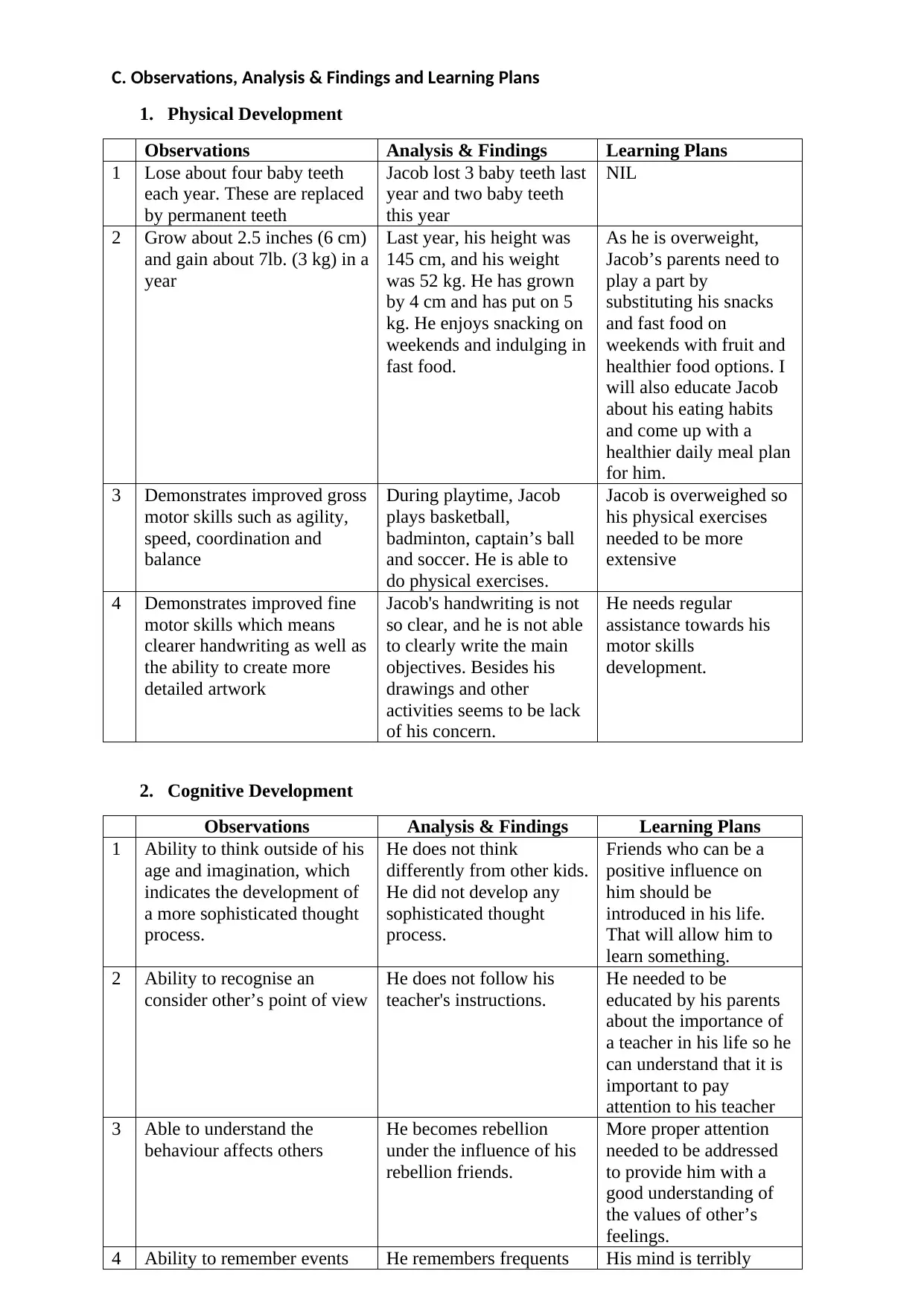
C. Observations, Analysis & Findings and Learning Plans
1. Physical Development
Observations Analysis & Findings Learning Plans
1 Lose about four baby teeth
each year. These are replaced
by permanent teeth
Jacob lost 3 baby teeth last
year and two baby teeth
this year
NIL
2 Grow about 2.5 inches (6 cm)
and gain about 7lb. (3 kg) in a
year
Last year, his height was
145 cm, and his weight
was 52 kg. He has grown
by 4 cm and has put on 5
kg. He enjoys snacking on
weekends and indulging in
fast food.
As he is overweight,
Jacob’s parents need to
play a part by
substituting his snacks
and fast food on
weekends with fruit and
healthier food options. I
will also educate Jacob
about his eating habits
and come up with a
healthier daily meal plan
for him.
3 Demonstrates improved gross
motor skills such as agility,
speed, coordination and
balance
During playtime, Jacob
plays basketball,
badminton, captain’s ball
and soccer. He is able to
do physical exercises.
Jacob is overweighed so
his physical exercises
needed to be more
extensive
4 Demonstrates improved fine
motor skills which means
clearer handwriting as well as
the ability to create more
detailed artwork
Jacob's handwriting is not
so clear, and he is not able
to clearly write the main
objectives. Besides his
drawings and other
activities seems to be lack
of his concern.
He needs regular
assistance towards his
motor skills
development.
2. Cognitive Development
Observations Analysis & Findings Learning Plans
1 Ability to think outside of his
age and imagination, which
indicates the development of
a more sophisticated thought
process.
He does not think
differently from other kids.
He did not develop any
sophisticated thought
process.
Friends who can be a
positive influence on
him should be
introduced in his life.
That will allow him to
learn something.
2 Ability to recognise an
consider other’s point of view
He does not follow his
teacher's instructions.
He needed to be
educated by his parents
about the importance of
a teacher in his life so he
can understand that it is
important to pay
attention to his teacher
3 Able to understand the
behaviour affects others
He becomes rebellion
under the influence of his
rebellion friends.
More proper attention
needed to be addressed
to provide him with a
good understanding of
the values of other’s
feelings.
4 Ability to remember events He remembers frequents His mind is terribly
1. Physical Development
Observations Analysis & Findings Learning Plans
1 Lose about four baby teeth
each year. These are replaced
by permanent teeth
Jacob lost 3 baby teeth last
year and two baby teeth
this year
NIL
2 Grow about 2.5 inches (6 cm)
and gain about 7lb. (3 kg) in a
year
Last year, his height was
145 cm, and his weight
was 52 kg. He has grown
by 4 cm and has put on 5
kg. He enjoys snacking on
weekends and indulging in
fast food.
As he is overweight,
Jacob’s parents need to
play a part by
substituting his snacks
and fast food on
weekends with fruit and
healthier food options. I
will also educate Jacob
about his eating habits
and come up with a
healthier daily meal plan
for him.
3 Demonstrates improved gross
motor skills such as agility,
speed, coordination and
balance
During playtime, Jacob
plays basketball,
badminton, captain’s ball
and soccer. He is able to
do physical exercises.
Jacob is overweighed so
his physical exercises
needed to be more
extensive
4 Demonstrates improved fine
motor skills which means
clearer handwriting as well as
the ability to create more
detailed artwork
Jacob's handwriting is not
so clear, and he is not able
to clearly write the main
objectives. Besides his
drawings and other
activities seems to be lack
of his concern.
He needs regular
assistance towards his
motor skills
development.
2. Cognitive Development
Observations Analysis & Findings Learning Plans
1 Ability to think outside of his
age and imagination, which
indicates the development of
a more sophisticated thought
process.
He does not think
differently from other kids.
He did not develop any
sophisticated thought
process.
Friends who can be a
positive influence on
him should be
introduced in his life.
That will allow him to
learn something.
2 Ability to recognise an
consider other’s point of view
He does not follow his
teacher's instructions.
He needed to be
educated by his parents
about the importance of
a teacher in his life so he
can understand that it is
important to pay
attention to his teacher
3 Able to understand the
behaviour affects others
He becomes rebellion
under the influence of his
rebellion friends.
More proper attention
needed to be addressed
to provide him with a
good understanding of
the values of other’s
feelings.
4 Ability to remember events He remembers frequents His mind is terribly
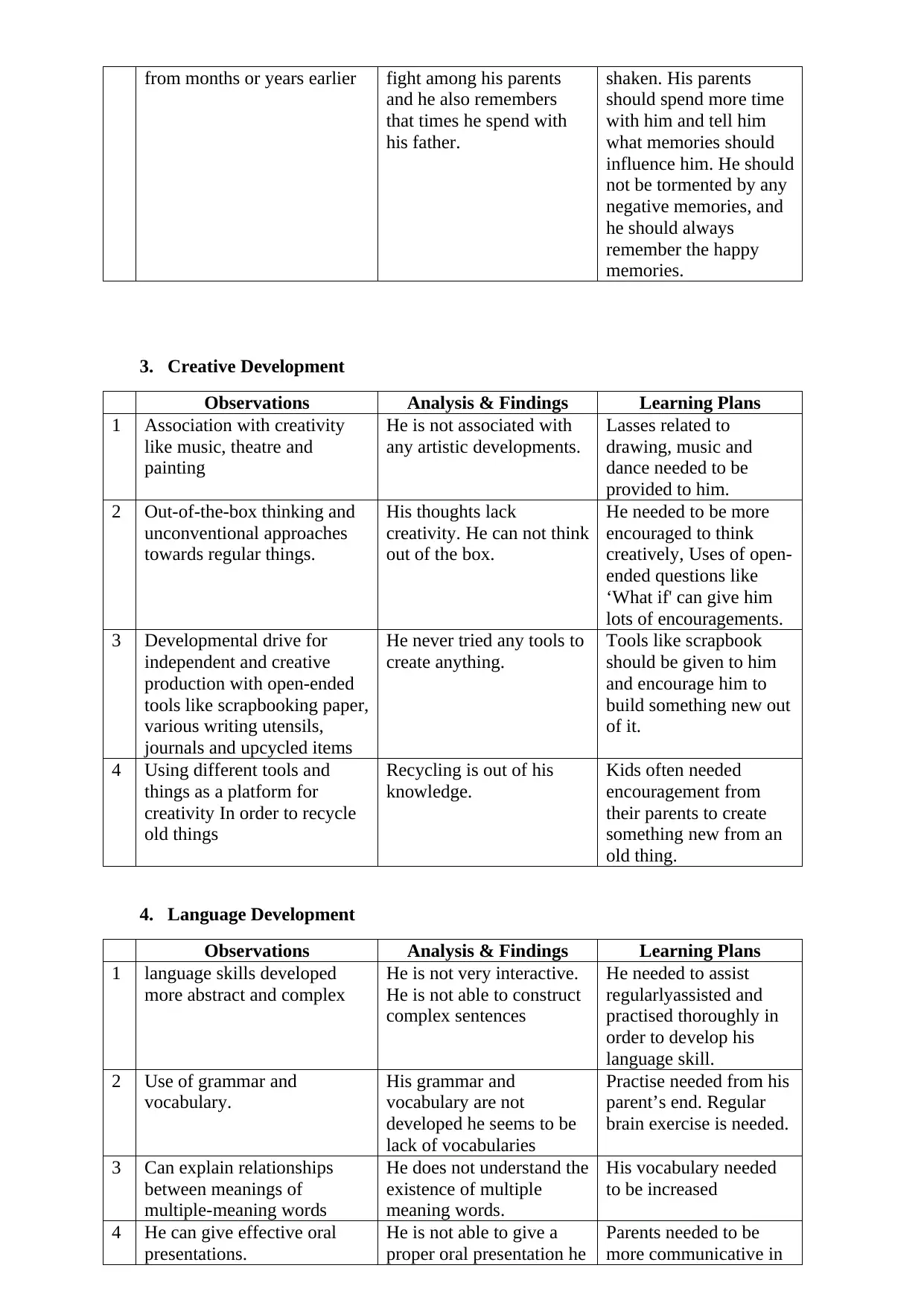
from months or years earlier fight among his parents
and he also remembers
that times he spend with
his father.
shaken. His parents
should spend more time
with him and tell him
what memories should
influence him. He should
not be tormented by any
negative memories, and
he should always
remember the happy
memories.
3. Creative Development
Observations Analysis & Findings Learning Plans
1 Association with creativity
like music, theatre and
painting
He is not associated with
any artistic developments.
Lasses related to
drawing, music and
dance needed to be
provided to him.
2 Out-of-the-box thinking and
unconventional approaches
towards regular things.
His thoughts lack
creativity. He can not think
out of the box.
He needed to be more
encouraged to think
creatively, Uses of open-
ended questions like
‘What if' can give him
lots of encouragements.
3 Developmental drive for
independent and creative
production with open-ended
tools like scrapbooking paper,
various writing utensils,
journals and upcycled items
He never tried any tools to
create anything.
Tools like scrapbook
should be given to him
and encourage him to
build something new out
of it.
4 Using different tools and
things as a platform for
creativity In order to recycle
old things
Recycling is out of his
knowledge.
Kids often needed
encouragement from
their parents to create
something new from an
old thing.
4. Language Development
Observations Analysis & Findings Learning Plans
1 language skills developed
more abstract and complex
He is not very interactive.
He is not able to construct
complex sentences
He needed to assist
regularlyassisted and
practised thoroughly in
order to develop his
language skill.
2 Use of grammar and
vocabulary.
His grammar and
vocabulary are not
developed he seems to be
lack of vocabularies
Practise needed from his
parent’s end. Regular
brain exercise is needed.
3 Can explain relationships
between meanings of
multiple-meaning words
He does not understand the
existence of multiple
meaning words.
His vocabulary needed
to be increased
4 He can give effective oral
presentations.
He is not able to give a
proper oral presentation he
Parents needed to be
more communicative in
and he also remembers
that times he spend with
his father.
shaken. His parents
should spend more time
with him and tell him
what memories should
influence him. He should
not be tormented by any
negative memories, and
he should always
remember the happy
memories.
3. Creative Development
Observations Analysis & Findings Learning Plans
1 Association with creativity
like music, theatre and
painting
He is not associated with
any artistic developments.
Lasses related to
drawing, music and
dance needed to be
provided to him.
2 Out-of-the-box thinking and
unconventional approaches
towards regular things.
His thoughts lack
creativity. He can not think
out of the box.
He needed to be more
encouraged to think
creatively, Uses of open-
ended questions like
‘What if' can give him
lots of encouragements.
3 Developmental drive for
independent and creative
production with open-ended
tools like scrapbooking paper,
various writing utensils,
journals and upcycled items
He never tried any tools to
create anything.
Tools like scrapbook
should be given to him
and encourage him to
build something new out
of it.
4 Using different tools and
things as a platform for
creativity In order to recycle
old things
Recycling is out of his
knowledge.
Kids often needed
encouragement from
their parents to create
something new from an
old thing.
4. Language Development
Observations Analysis & Findings Learning Plans
1 language skills developed
more abstract and complex
He is not very interactive.
He is not able to construct
complex sentences
He needed to assist
regularlyassisted and
practised thoroughly in
order to develop his
language skill.
2 Use of grammar and
vocabulary.
His grammar and
vocabulary are not
developed he seems to be
lack of vocabularies
Practise needed from his
parent’s end. Regular
brain exercise is needed.
3 Can explain relationships
between meanings of
multiple-meaning words
He does not understand the
existence of multiple
meaning words.
His vocabulary needed
to be increased
4 He can give effective oral
presentations.
He is not able to give a
proper oral presentation he
Parents needed to be
more communicative in
Paraphrase This Document
Need a fresh take? Get an instant paraphrase of this document with our AI Paraphraser
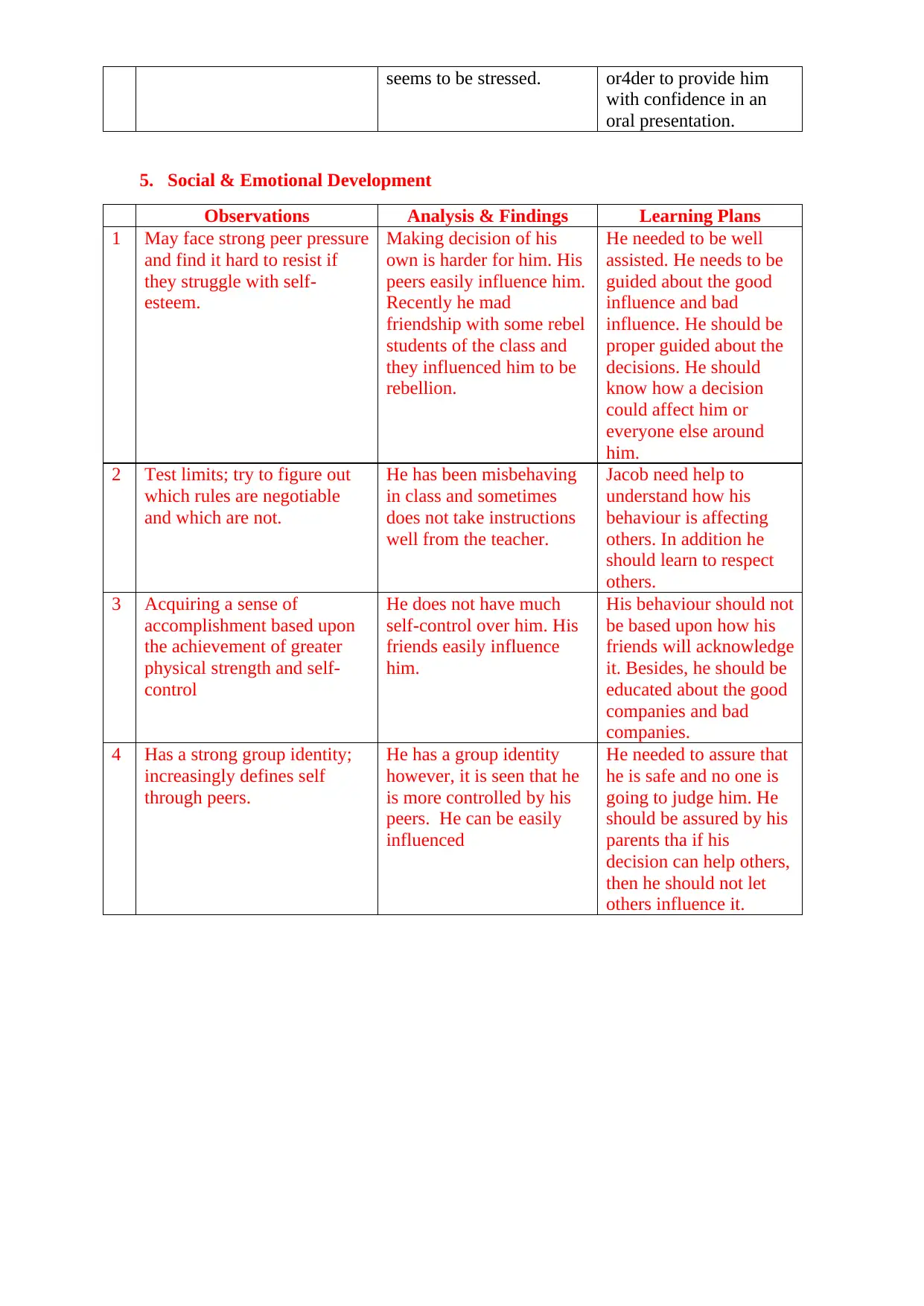
seems to be stressed. or4der to provide him
with confidence in an
oral presentation.
5. Social & Emotional Development
Observations Analysis & Findings Learning Plans
1 May face strong peer pressure
and find it hard to resist if
they struggle with self-
esteem.
Making decision of his
own is harder for him. His
peers easily influence him.
Recently he mad
friendship with some rebel
students of the class and
they influenced him to be
rebellion.
He needed to be well
assisted. He needs to be
guided about the good
influence and bad
influence. He should be
proper guided about the
decisions. He should
know how a decision
could affect him or
everyone else around
him.
2 Test limits; try to figure out
which rules are negotiable
and which are not.
He has been misbehaving
in class and sometimes
does not take instructions
well from the teacher.
Jacob need help to
understand how his
behaviour is affecting
others. In addition he
should learn to respect
others.
3 Acquiring a sense of
accomplishment based upon
the achievement of greater
physical strength and self-
control
He does not have much
self-control over him. His
friends easily influence
him.
His behaviour should not
be based upon how his
friends will acknowledge
it. Besides, he should be
educated about the good
companies and bad
companies.
4 Has a strong group identity;
increasingly defines self
through peers.
He has a group identity
however, it is seen that he
is more controlled by his
peers. He can be easily
influenced
He needed to assure that
he is safe and no one is
going to judge him. He
should be assured by his
parents tha if his
decision can help others,
then he should not let
others influence it.
with confidence in an
oral presentation.
5. Social & Emotional Development
Observations Analysis & Findings Learning Plans
1 May face strong peer pressure
and find it hard to resist if
they struggle with self-
esteem.
Making decision of his
own is harder for him. His
peers easily influence him.
Recently he mad
friendship with some rebel
students of the class and
they influenced him to be
rebellion.
He needed to be well
assisted. He needs to be
guided about the good
influence and bad
influence. He should be
proper guided about the
decisions. He should
know how a decision
could affect him or
everyone else around
him.
2 Test limits; try to figure out
which rules are negotiable
and which are not.
He has been misbehaving
in class and sometimes
does not take instructions
well from the teacher.
Jacob need help to
understand how his
behaviour is affecting
others. In addition he
should learn to respect
others.
3 Acquiring a sense of
accomplishment based upon
the achievement of greater
physical strength and self-
control
He does not have much
self-control over him. His
friends easily influence
him.
His behaviour should not
be based upon how his
friends will acknowledge
it. Besides, he should be
educated about the good
companies and bad
companies.
4 Has a strong group identity;
increasingly defines self
through peers.
He has a group identity
however, it is seen that he
is more controlled by his
peers. He can be easily
influenced
He needed to assure that
he is safe and no one is
going to judge him. He
should be assured by his
parents tha if his
decision can help others,
then he should not let
others influence it.
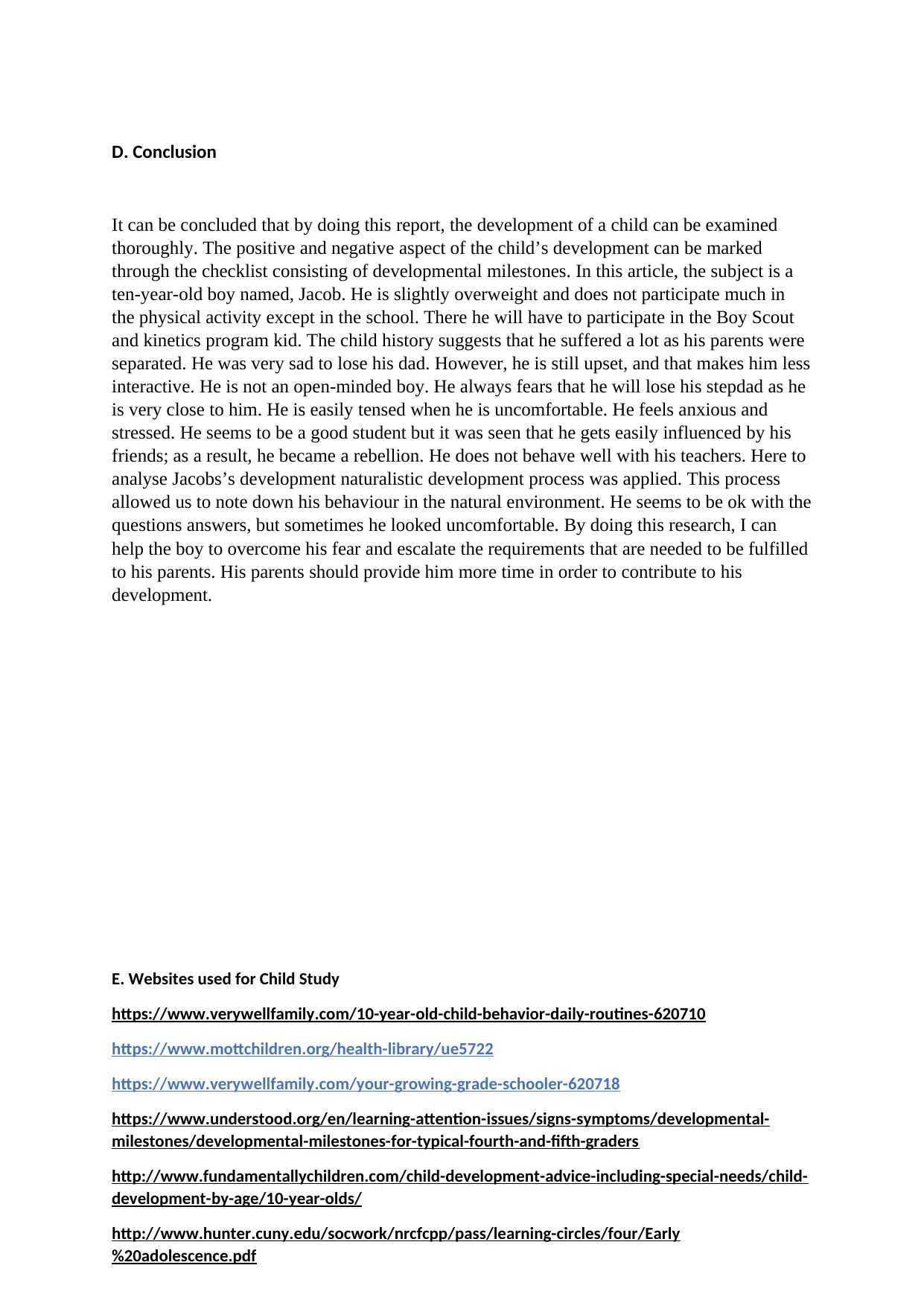
D. Conclusion
It can be concluded that by doing this report, the development of a child can be examined
thoroughly. The positive and negative aspect of the child’s development can be marked
through the checklist consisting of developmental milestones. In this article, the subject is a
ten-year-old boy named, Jacob. He is slightly overweight and does not participate much in
the physical activity except in the school. There he will have to participate in the Boy Scout
and kinetics program kid. The child history suggests that he suffered a lot as his parents were
separated. He was very sad to lose his dad. However, he is still upset, and that makes him less
interactive. He is not an open-minded boy. He always fears that he will lose his stepdad as he
is very close to him. He is easily tensed when he is uncomfortable. He feels anxious and
stressed. He seems to be a good student but it was seen that he gets easily influenced by his
friends; as a result, he became a rebellion. He does not behave well with his teachers. Here to
analyse Jacobs’s development naturalistic development process was applied. This process
allowed us to note down his behaviour in the natural environment. He seems to be ok with the
questions answers, but sometimes he looked uncomfortable. By doing this research, I can
help the boy to overcome his fear and escalate the requirements that are needed to be fulfilled
to his parents. His parents should provide him more time in order to contribute to his
development.
E. Websites used for Child Study
https://www.verywellfamily.com/10-year-old-child-behavior-daily-routines-620710
https://www.mottchildren.org/health-library/ue5722
https://www.verywellfamily.com/your-growing-grade-schooler-620718
https://www.understood.org/en/learning-attention-issues/signs-symptoms/developmental-
milestones/developmental-milestones-for-typical-fourth-and-fifth-graders
http://www.fundamentallychildren.com/child-development-advice-including-special-needs/child-
development-by-age/10-year-olds/
http://www.hunter.cuny.edu/socwork/nrcfcpp/pass/learning-circles/four/Early
%20adolescence.pdf
It can be concluded that by doing this report, the development of a child can be examined
thoroughly. The positive and negative aspect of the child’s development can be marked
through the checklist consisting of developmental milestones. In this article, the subject is a
ten-year-old boy named, Jacob. He is slightly overweight and does not participate much in
the physical activity except in the school. There he will have to participate in the Boy Scout
and kinetics program kid. The child history suggests that he suffered a lot as his parents were
separated. He was very sad to lose his dad. However, he is still upset, and that makes him less
interactive. He is not an open-minded boy. He always fears that he will lose his stepdad as he
is very close to him. He is easily tensed when he is uncomfortable. He feels anxious and
stressed. He seems to be a good student but it was seen that he gets easily influenced by his
friends; as a result, he became a rebellion. He does not behave well with his teachers. Here to
analyse Jacobs’s development naturalistic development process was applied. This process
allowed us to note down his behaviour in the natural environment. He seems to be ok with the
questions answers, but sometimes he looked uncomfortable. By doing this research, I can
help the boy to overcome his fear and escalate the requirements that are needed to be fulfilled
to his parents. His parents should provide him more time in order to contribute to his
development.
E. Websites used for Child Study
https://www.verywellfamily.com/10-year-old-child-behavior-daily-routines-620710
https://www.mottchildren.org/health-library/ue5722
https://www.verywellfamily.com/your-growing-grade-schooler-620718
https://www.understood.org/en/learning-attention-issues/signs-symptoms/developmental-
milestones/developmental-milestones-for-typical-fourth-and-fifth-graders
http://www.fundamentallychildren.com/child-development-advice-including-special-needs/child-
development-by-age/10-year-olds/
http://www.hunter.cuny.edu/socwork/nrcfcpp/pass/learning-circles/four/Early
%20adolescence.pdf

References:
Owens Jr, R.E., 2015. Language development: An introduction. Pearson.
Parke, R.D. and Ladd, G.W. eds., 2016. Family-peer relationships: Modes of linkage.
Routledge
Owens Jr, R.E., 2015. Language development: An introduction. Pearson.
Parke, R.D. and Ladd, G.W. eds., 2016. Family-peer relationships: Modes of linkage.
Routledge
Secure Best Marks with AI Grader
Need help grading? Try our AI Grader for instant feedback on your assignments.
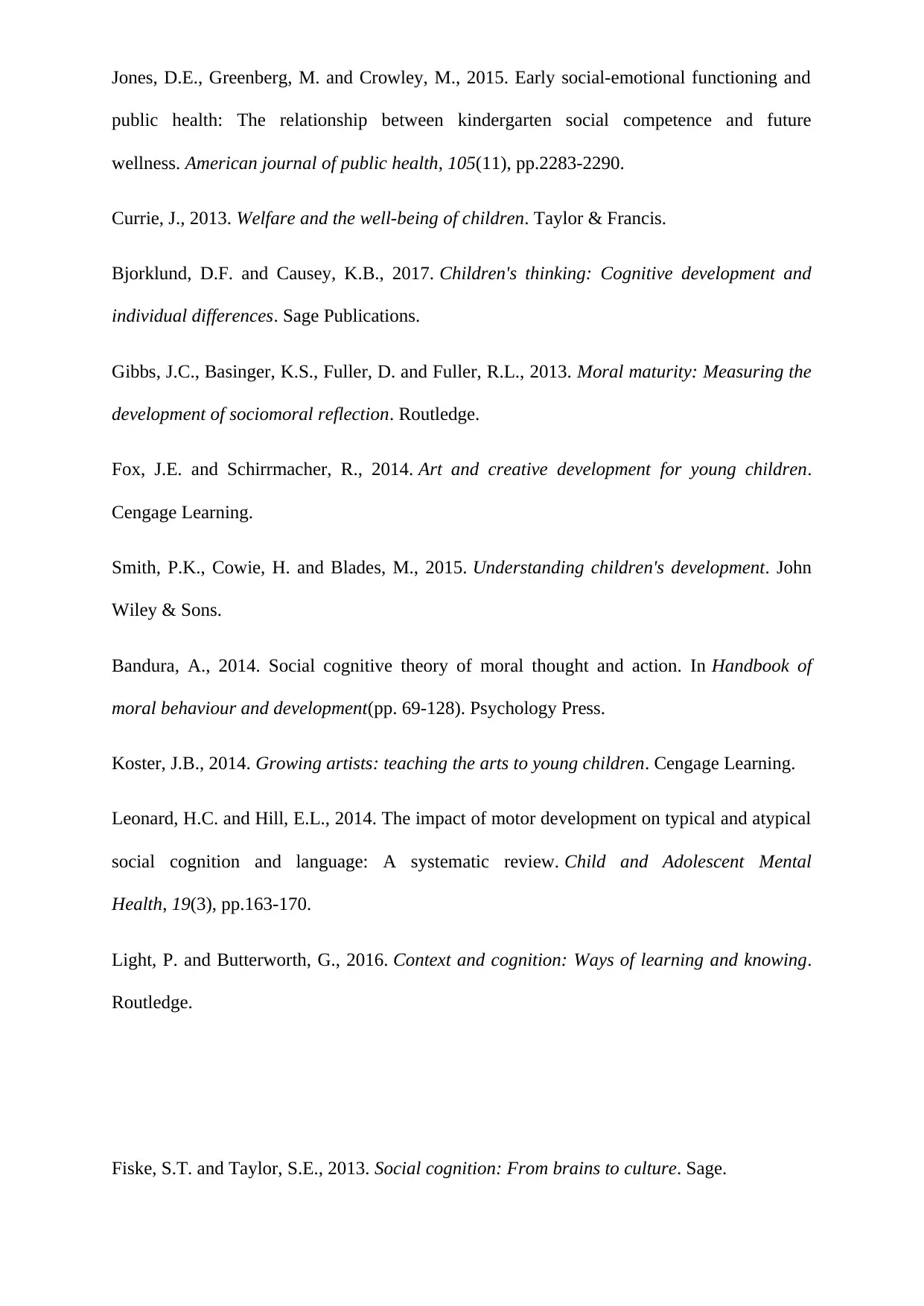
Jones, D.E., Greenberg, M. and Crowley, M., 2015. Early social-emotional functioning and
public health: The relationship between kindergarten social competence and future
wellness. American journal of public health, 105(11), pp.2283-2290.
Currie, J., 2013. Welfare and the well-being of children. Taylor & Francis.
Bjorklund, D.F. and Causey, K.B., 2017. Children's thinking: Cognitive development and
individual differences. Sage Publications.
Gibbs, J.C., Basinger, K.S., Fuller, D. and Fuller, R.L., 2013. Moral maturity: Measuring the
development of sociomoral reflection. Routledge.
Fox, J.E. and Schirrmacher, R., 2014. Art and creative development for young children.
Cengage Learning.
Smith, P.K., Cowie, H. and Blades, M., 2015. Understanding children's development. John
Wiley & Sons.
Bandura, A., 2014. Social cognitive theory of moral thought and action. In Handbook of
moral behaviour and development(pp. 69-128). Psychology Press.
Koster, J.B., 2014. Growing artists: teaching the arts to young children. Cengage Learning.
Leonard, H.C. and Hill, E.L., 2014. The impact of motor development on typical and atypical
social cognition and language: A systematic review. Child and Adolescent Mental
Health, 19(3), pp.163-170.
Light, P. and Butterworth, G., 2016. Context and cognition: Ways of learning and knowing.
Routledge.
Fiske, S.T. and Taylor, S.E., 2013. Social cognition: From brains to culture. Sage.
public health: The relationship between kindergarten social competence and future
wellness. American journal of public health, 105(11), pp.2283-2290.
Currie, J., 2013. Welfare and the well-being of children. Taylor & Francis.
Bjorklund, D.F. and Causey, K.B., 2017. Children's thinking: Cognitive development and
individual differences. Sage Publications.
Gibbs, J.C., Basinger, K.S., Fuller, D. and Fuller, R.L., 2013. Moral maturity: Measuring the
development of sociomoral reflection. Routledge.
Fox, J.E. and Schirrmacher, R., 2014. Art and creative development for young children.
Cengage Learning.
Smith, P.K., Cowie, H. and Blades, M., 2015. Understanding children's development. John
Wiley & Sons.
Bandura, A., 2014. Social cognitive theory of moral thought and action. In Handbook of
moral behaviour and development(pp. 69-128). Psychology Press.
Koster, J.B., 2014. Growing artists: teaching the arts to young children. Cengage Learning.
Leonard, H.C. and Hill, E.L., 2014. The impact of motor development on typical and atypical
social cognition and language: A systematic review. Child and Adolescent Mental
Health, 19(3), pp.163-170.
Light, P. and Butterworth, G., 2016. Context and cognition: Ways of learning and knowing.
Routledge.
Fiske, S.T. and Taylor, S.E., 2013. Social cognition: From brains to culture. Sage.

Shaffer, D.R. and Kipp, K., 2013. Developmental psychology: Childhood and adolescence.
Cengage Learning.
Reid, S., 2013. Developments in infant observation: The Tavistock model. Routledge.
Gesell, A., 2013. Vision-its development in infant and child. Read Books Ltd.
G. Appendix
Cengage Learning.
Reid, S., 2013. Developments in infant observation: The Tavistock model. Routledge.
Gesell, A., 2013. Vision-its development in infant and child. Read Books Ltd.
G. Appendix
1 out of 18
Your All-in-One AI-Powered Toolkit for Academic Success.
+13062052269
info@desklib.com
Available 24*7 on WhatsApp / Email
![[object Object]](/_next/static/media/star-bottom.7253800d.svg)
Unlock your academic potential
© 2024 | Zucol Services PVT LTD | All rights reserved.

